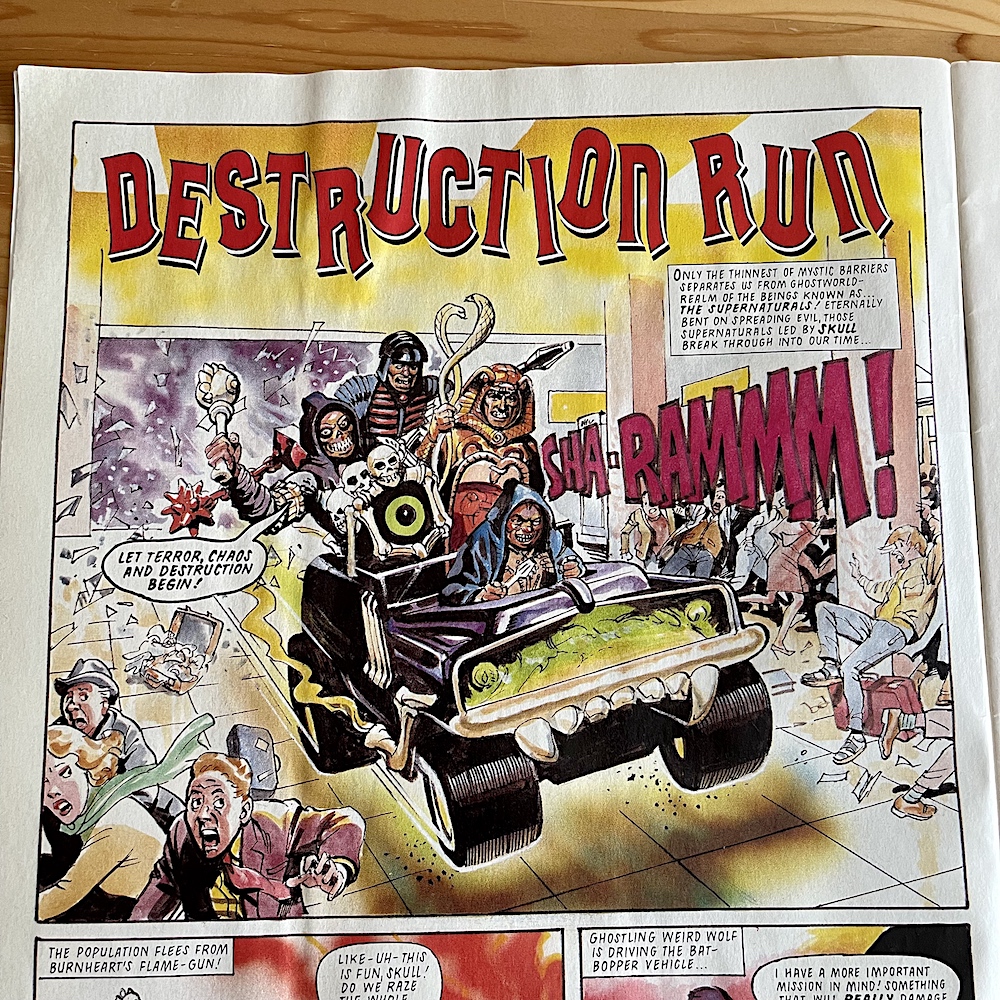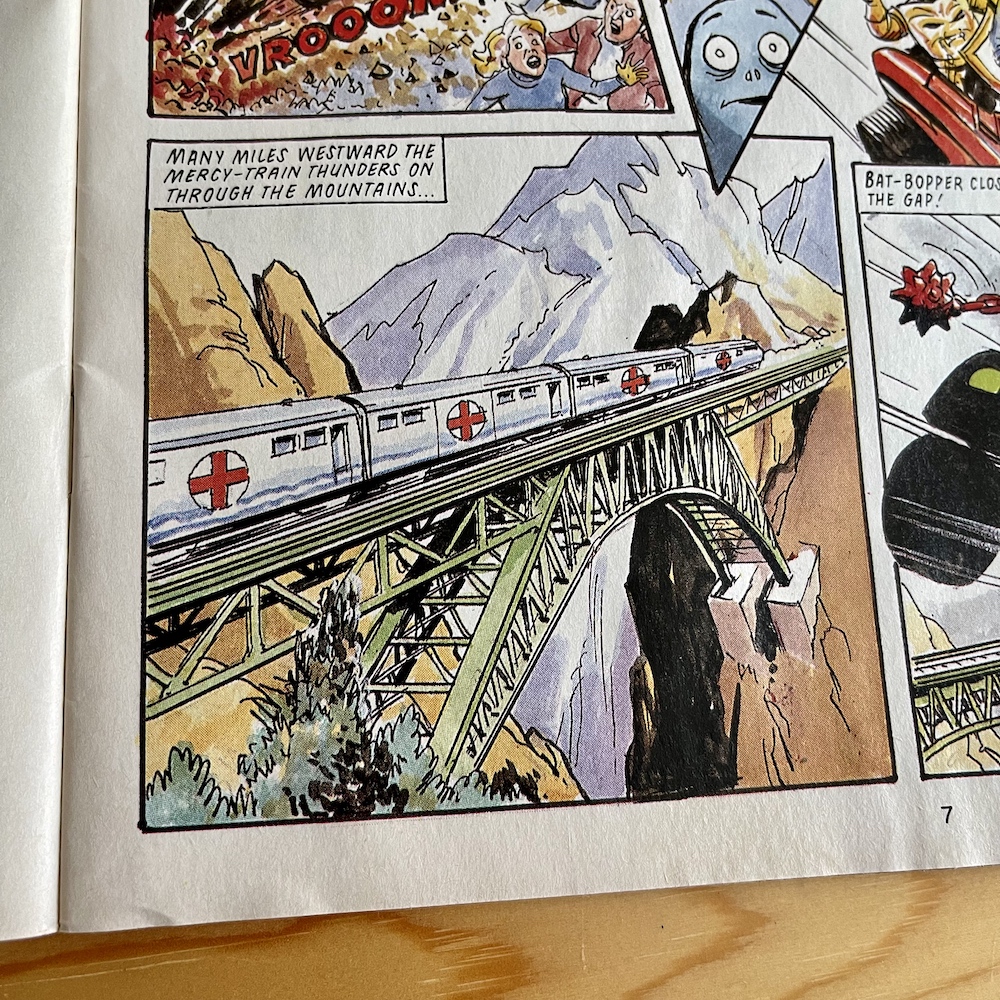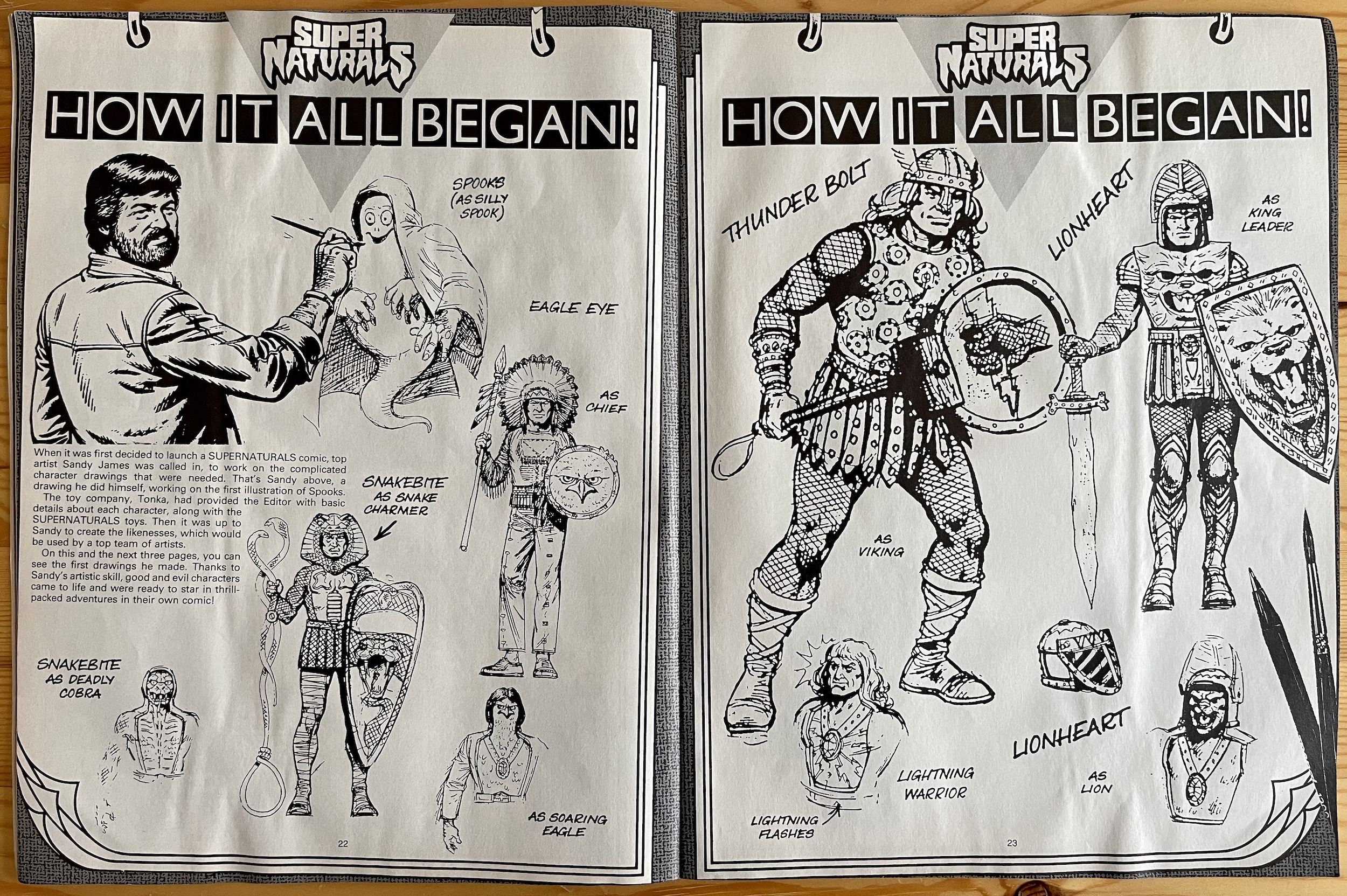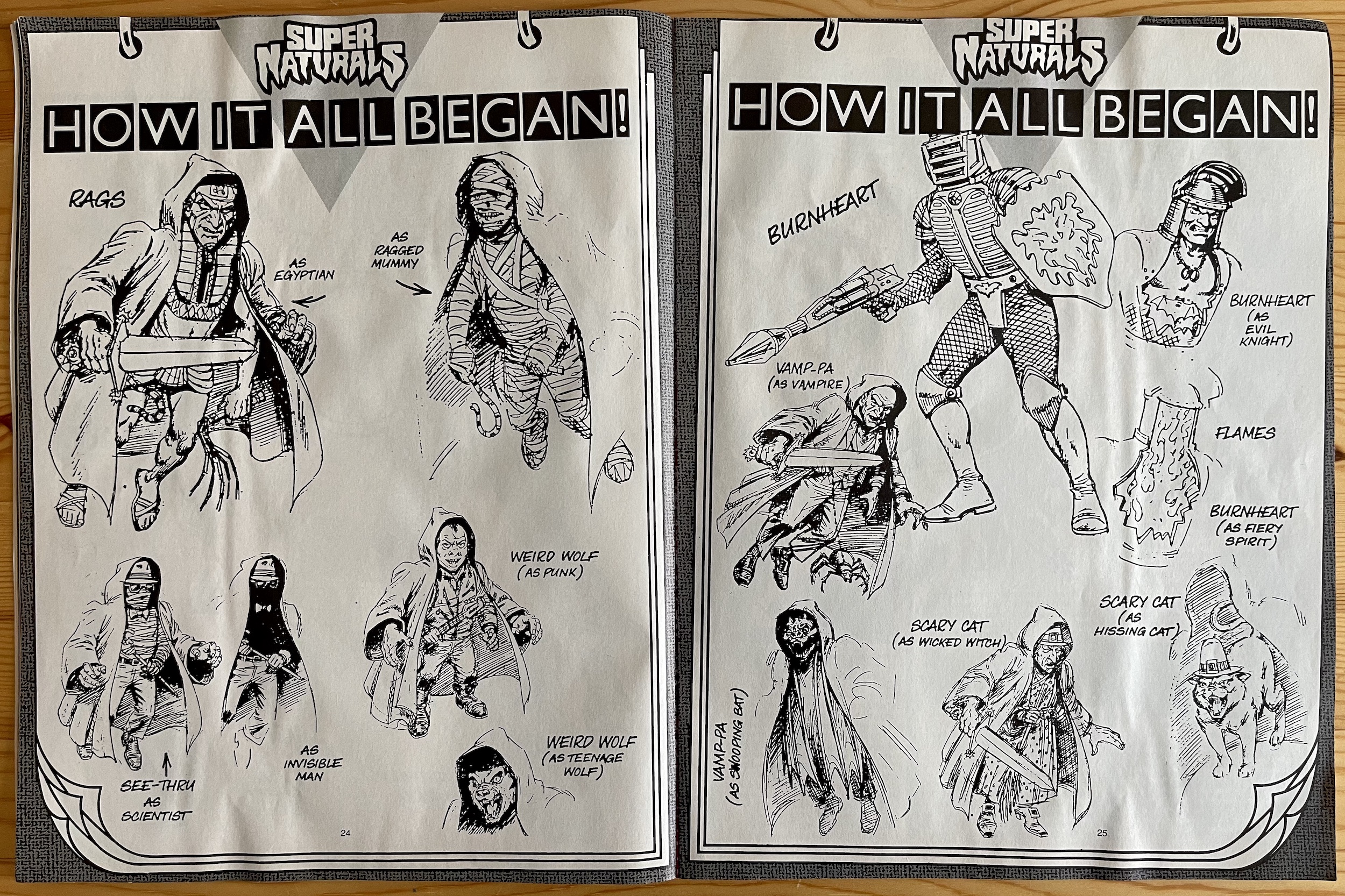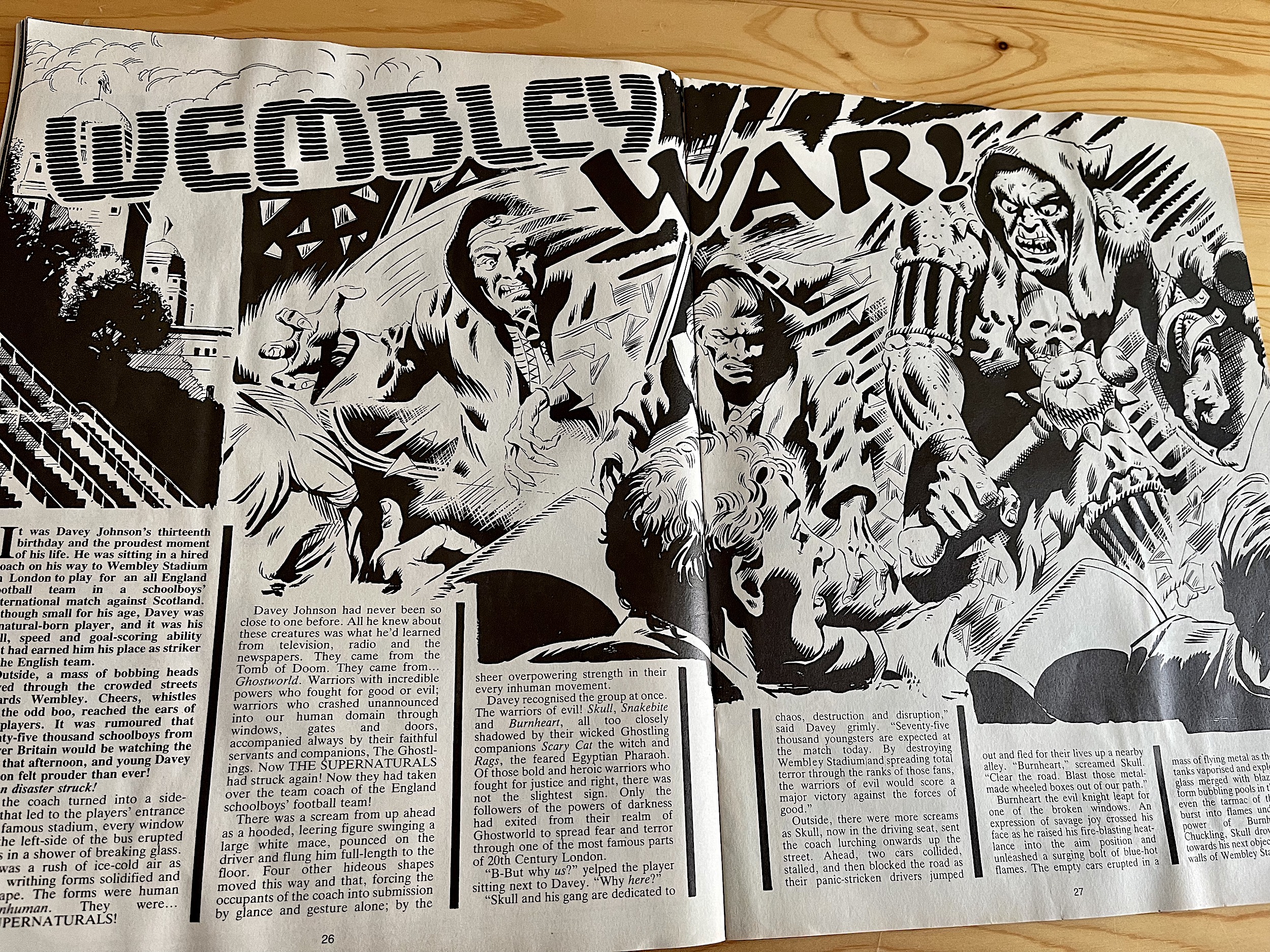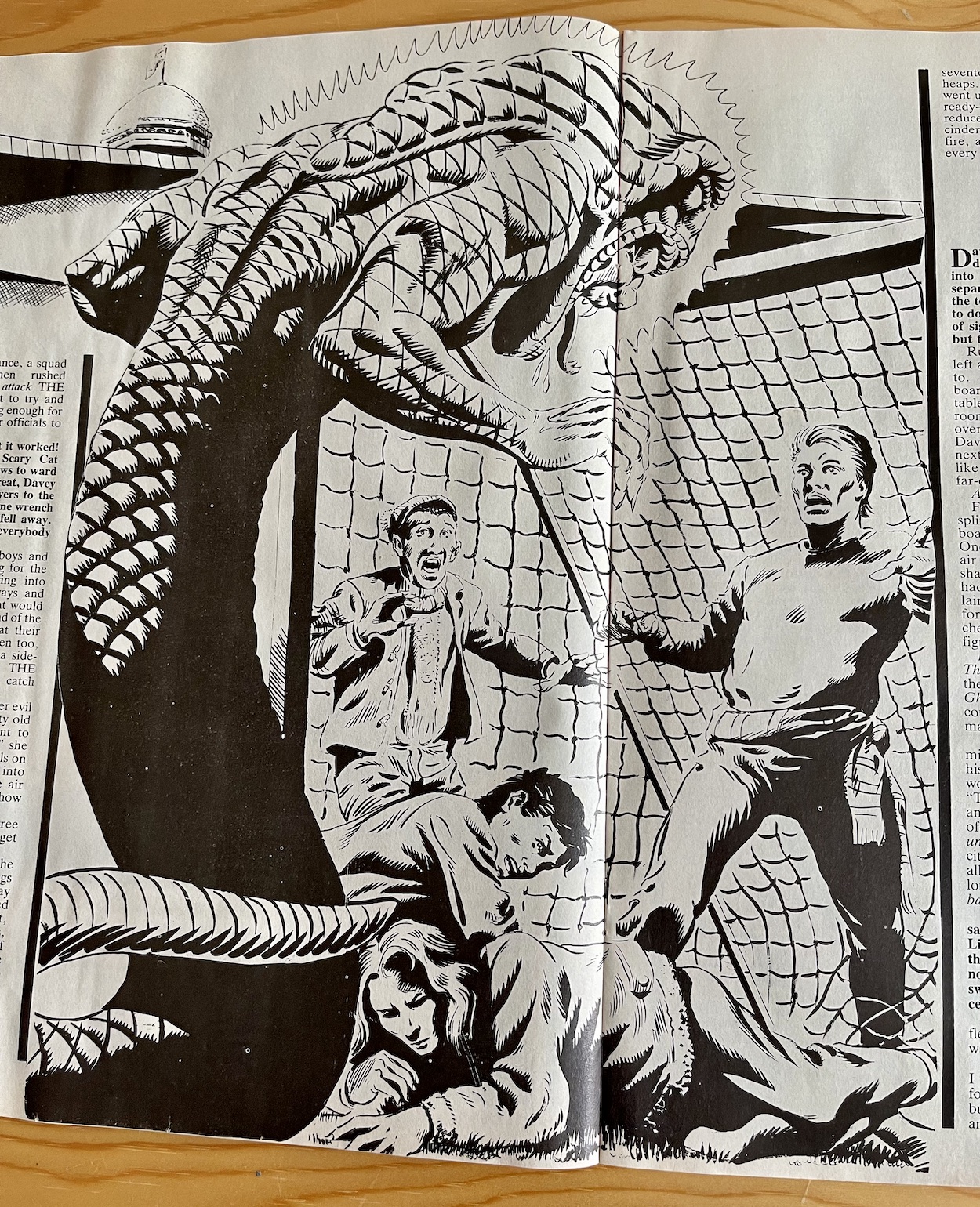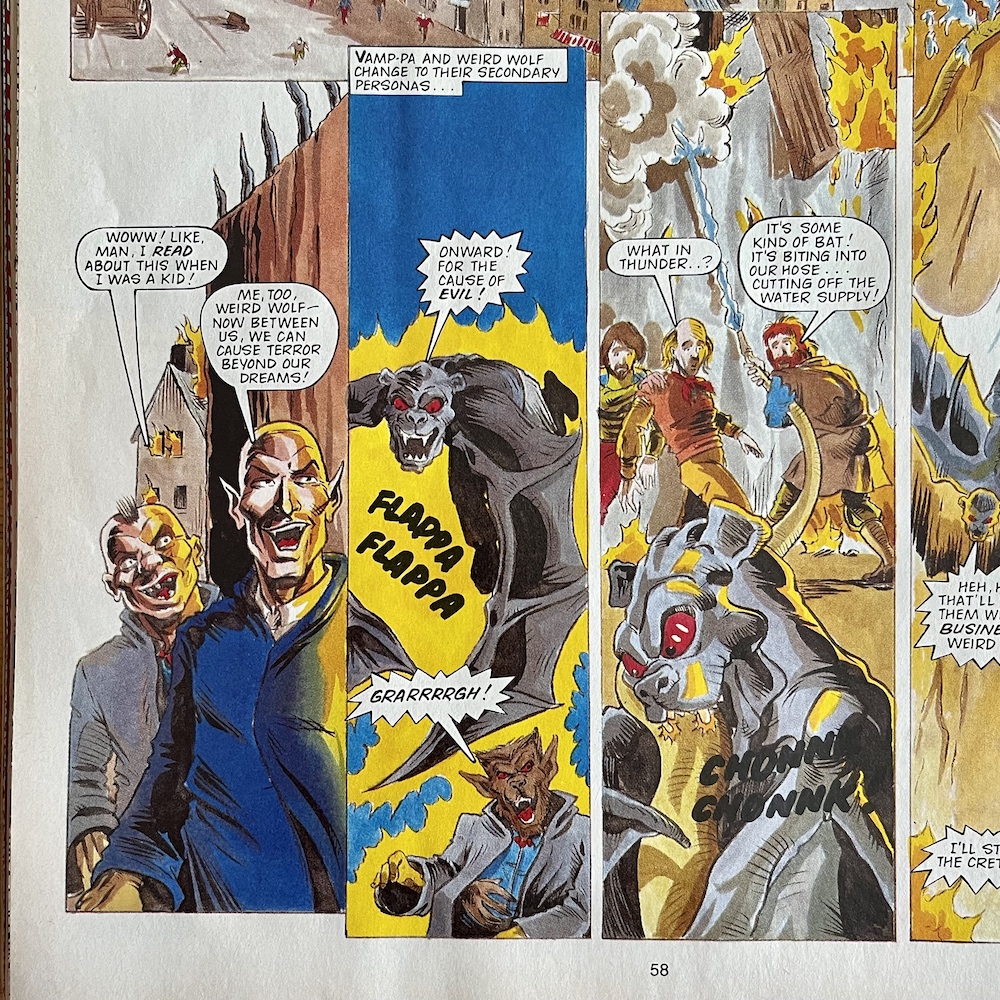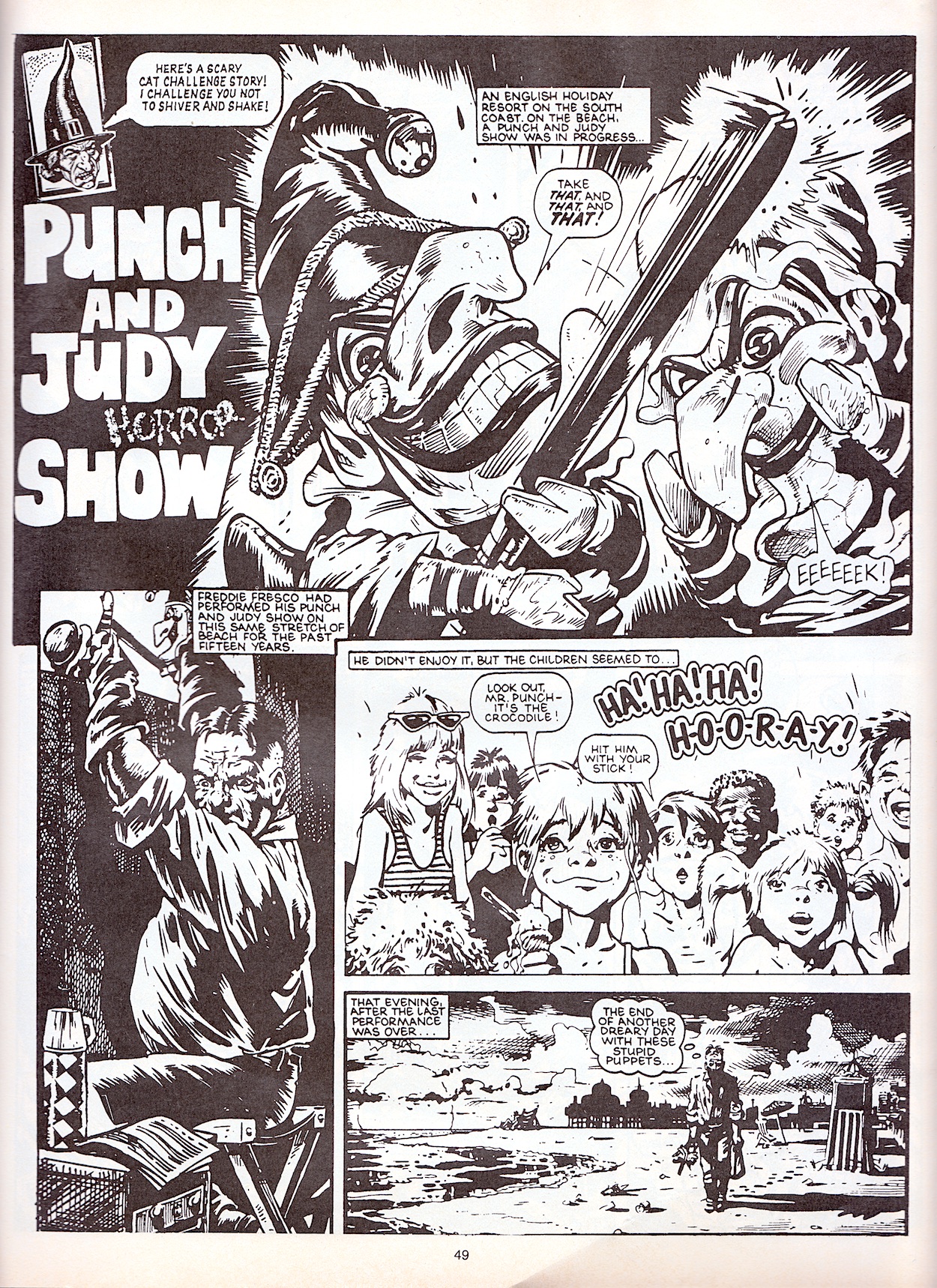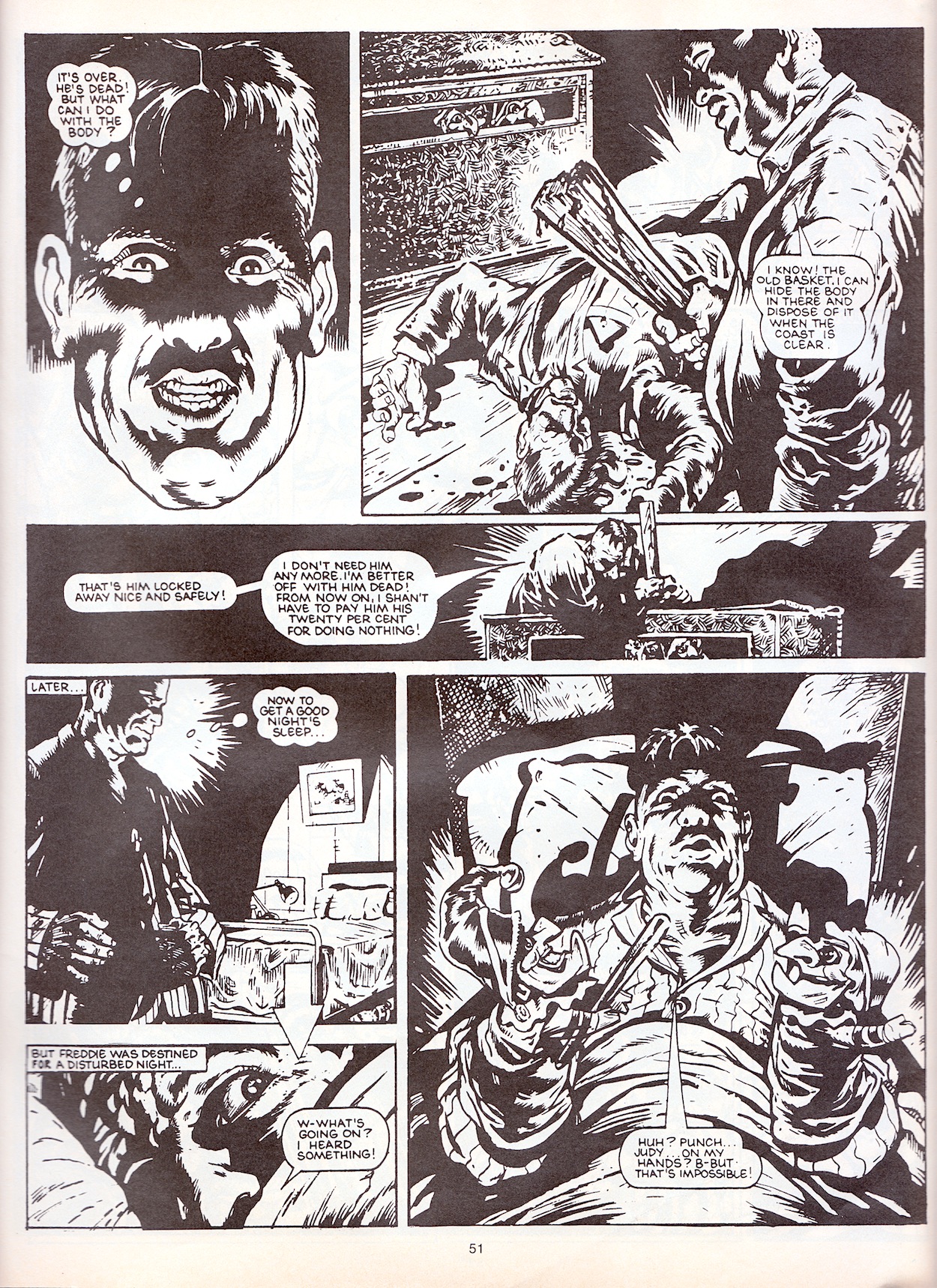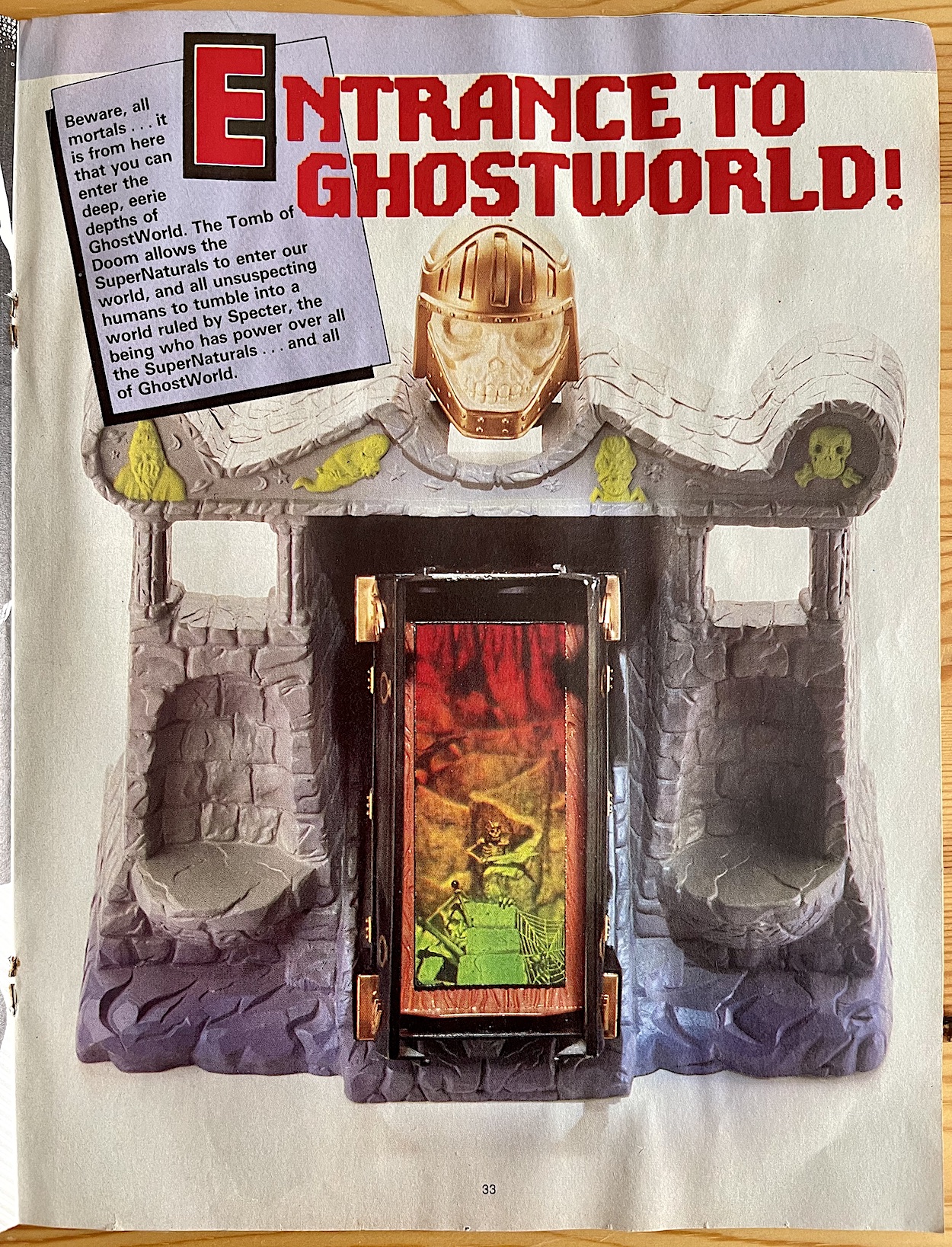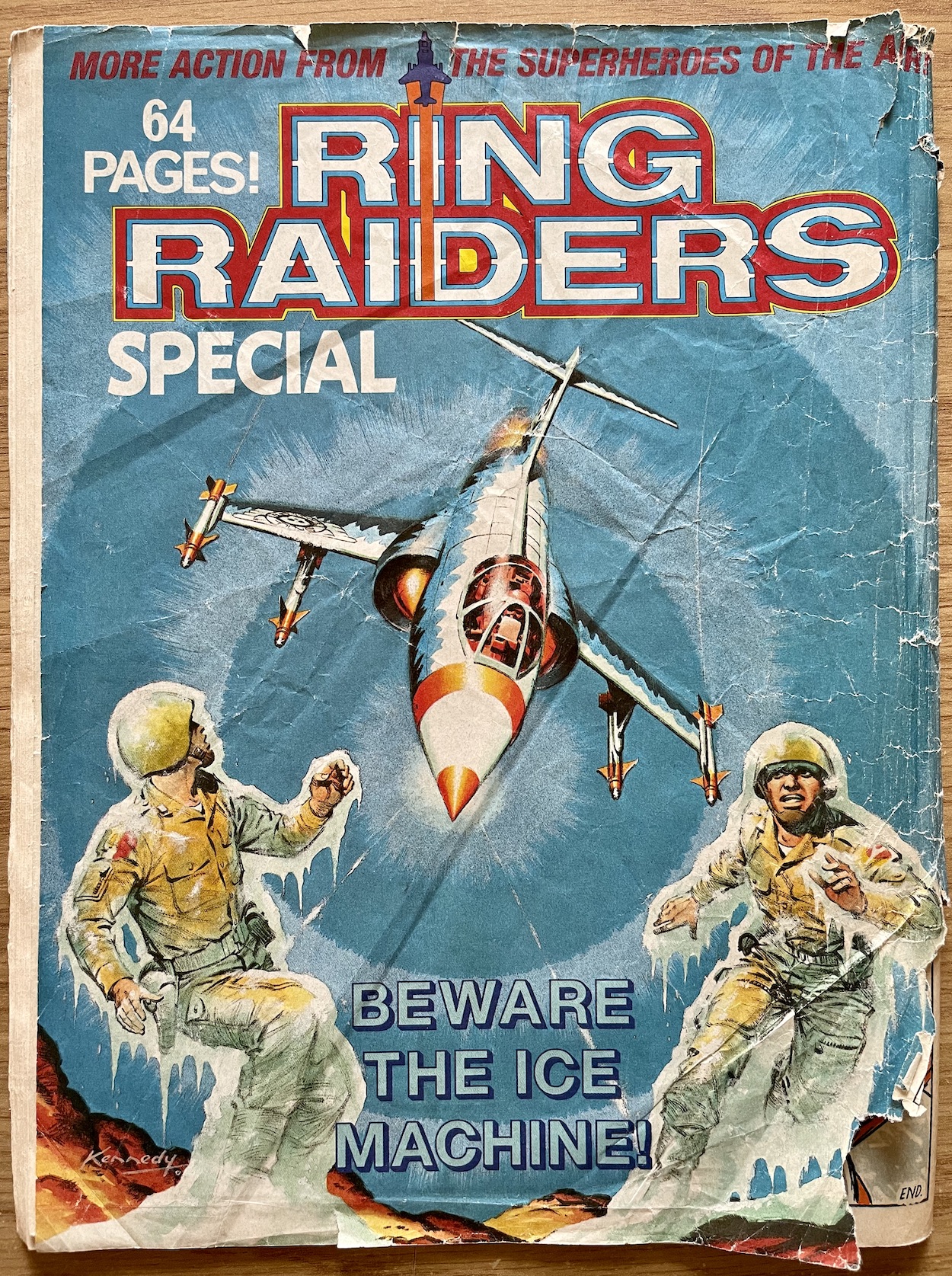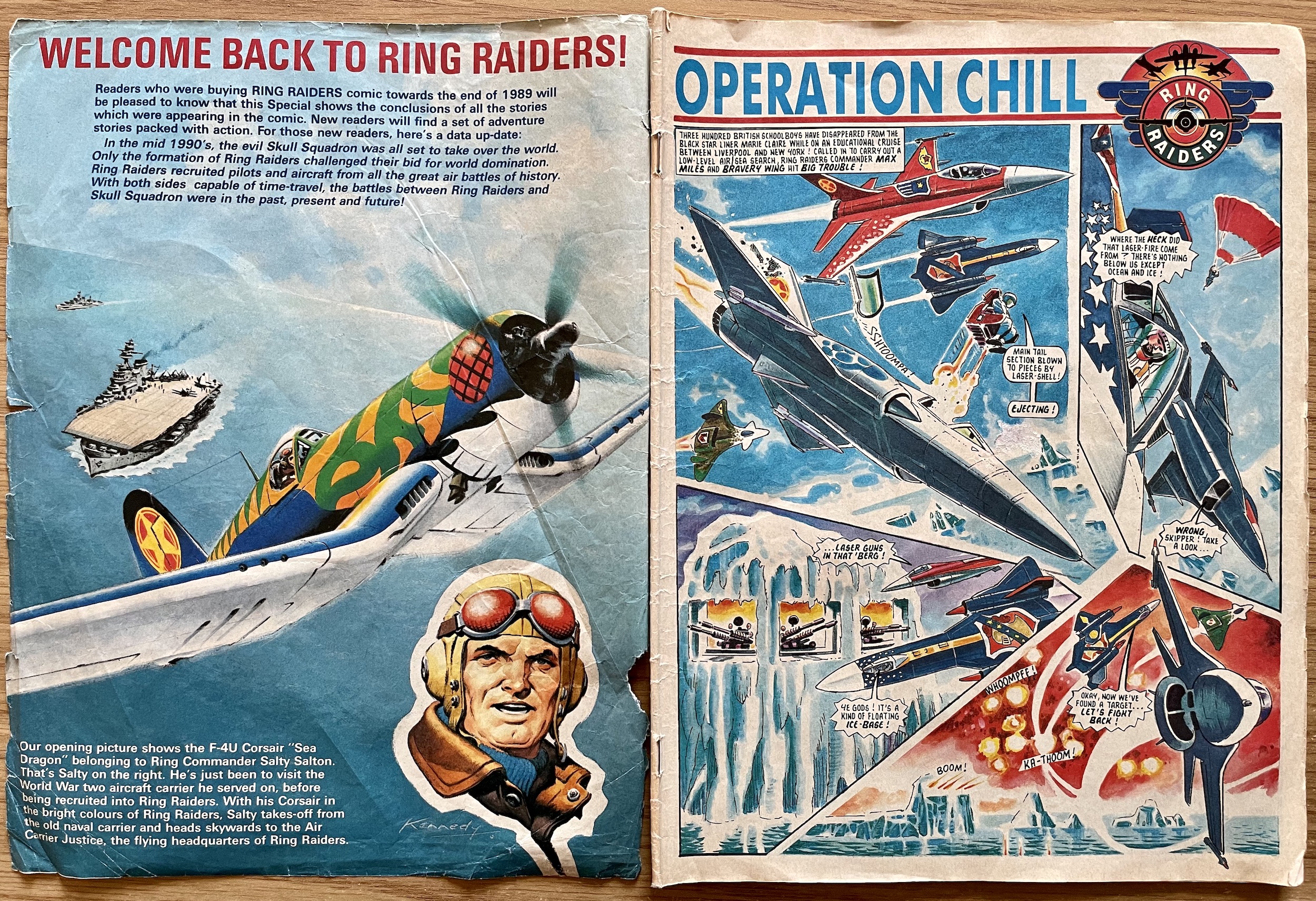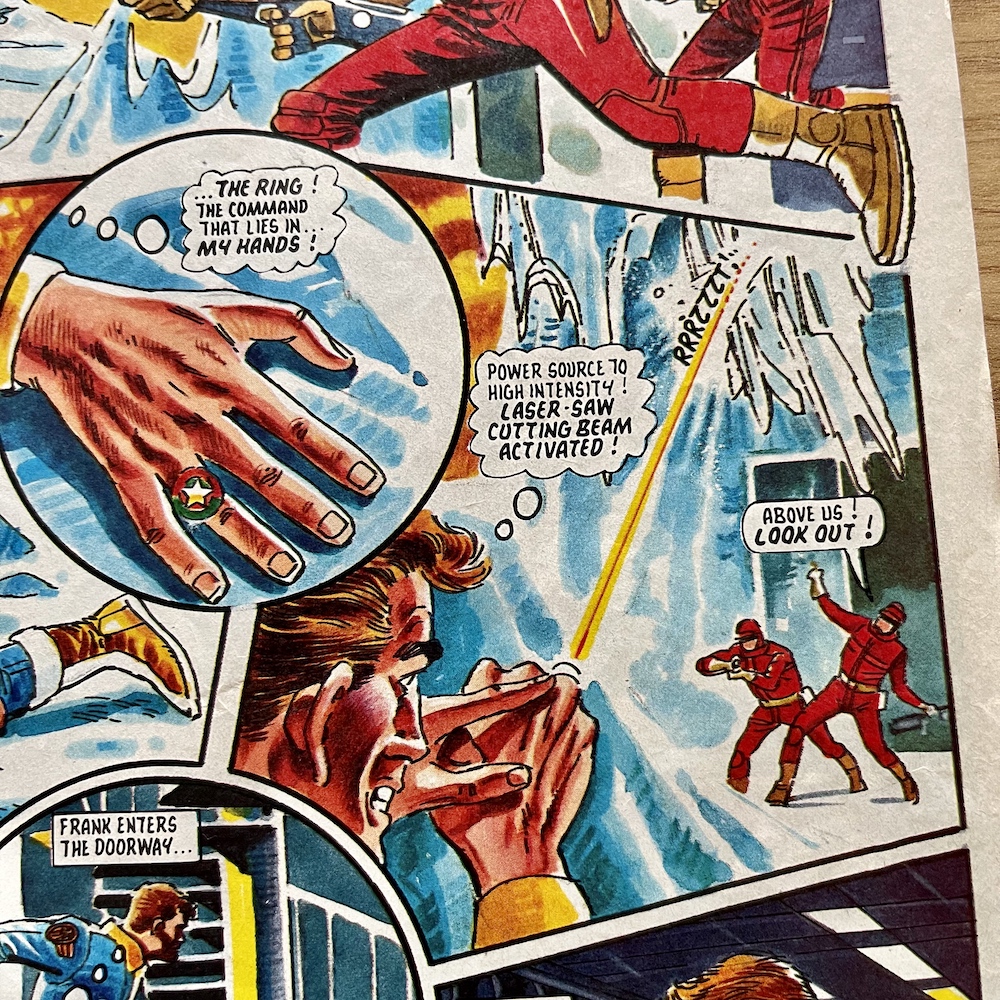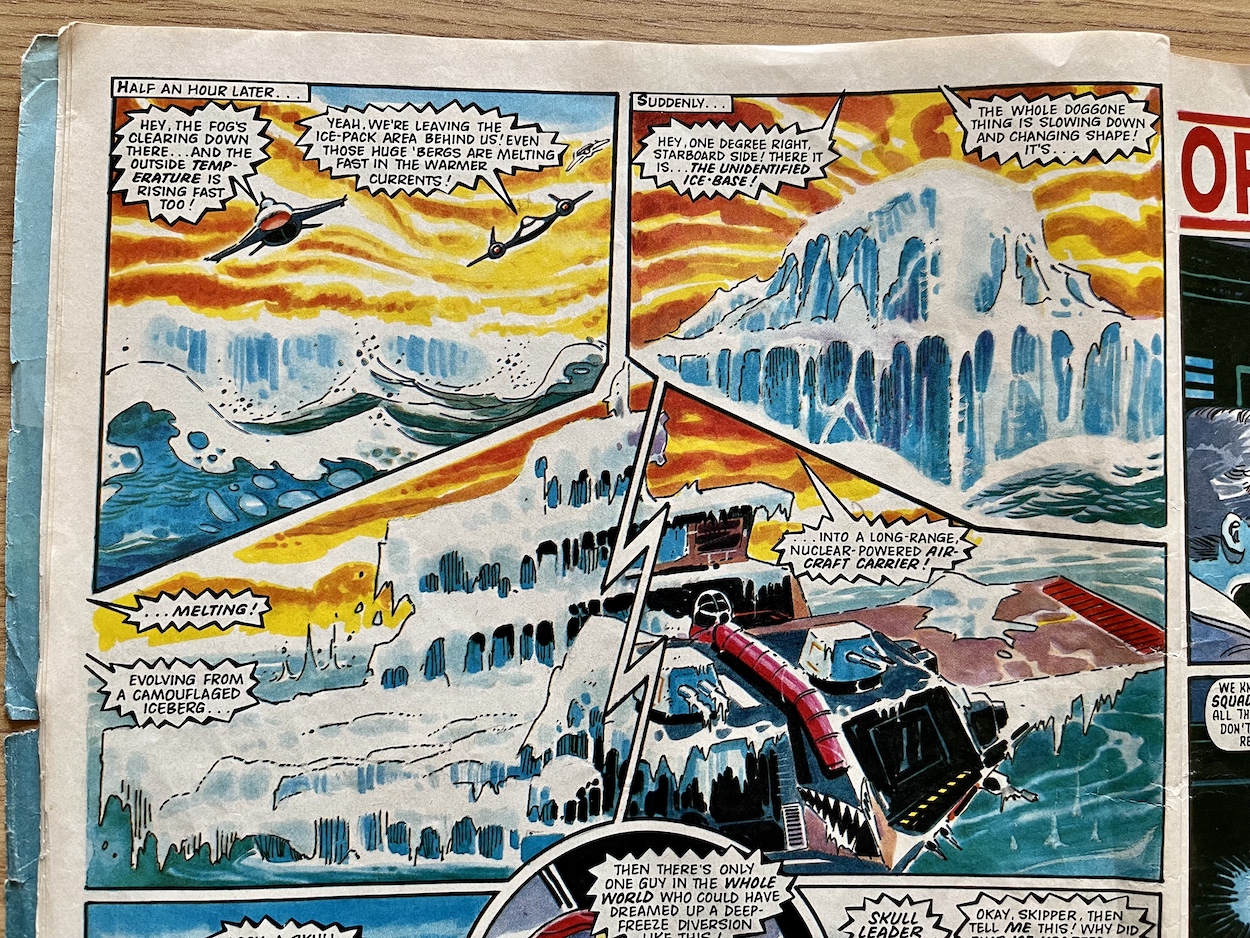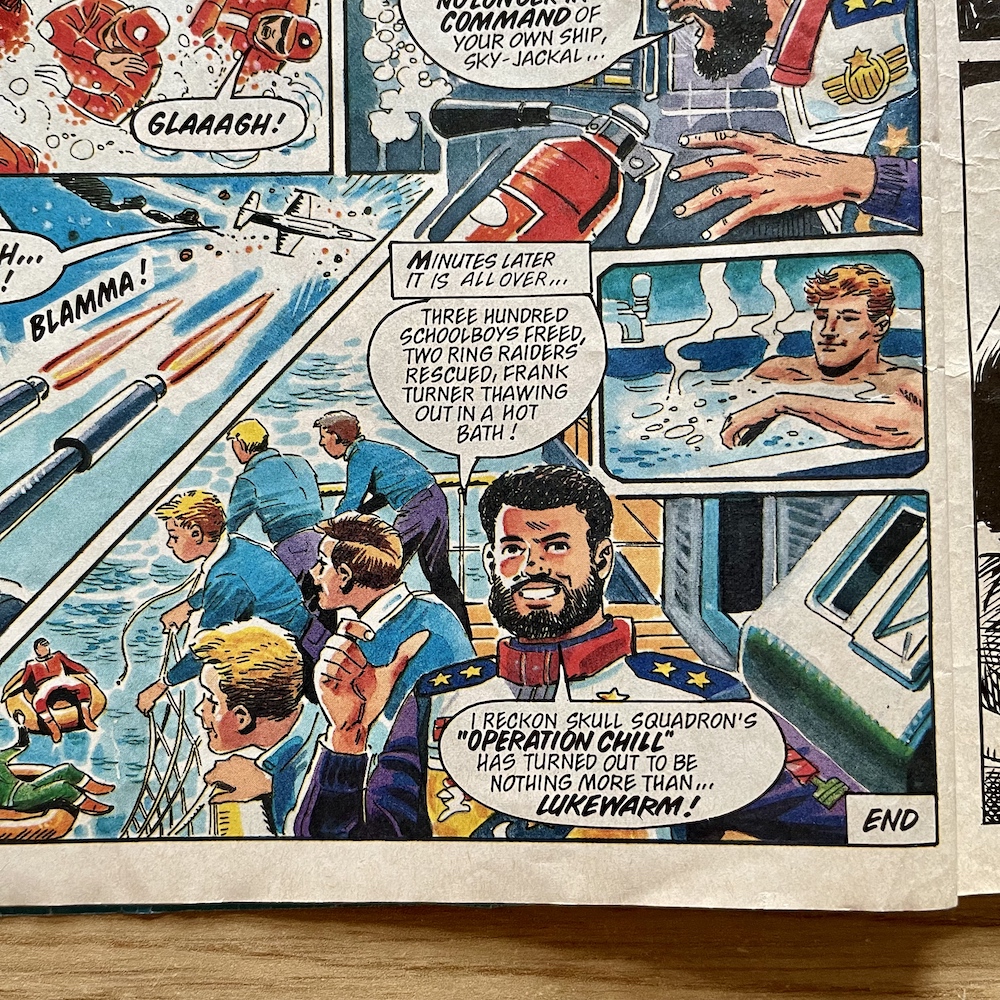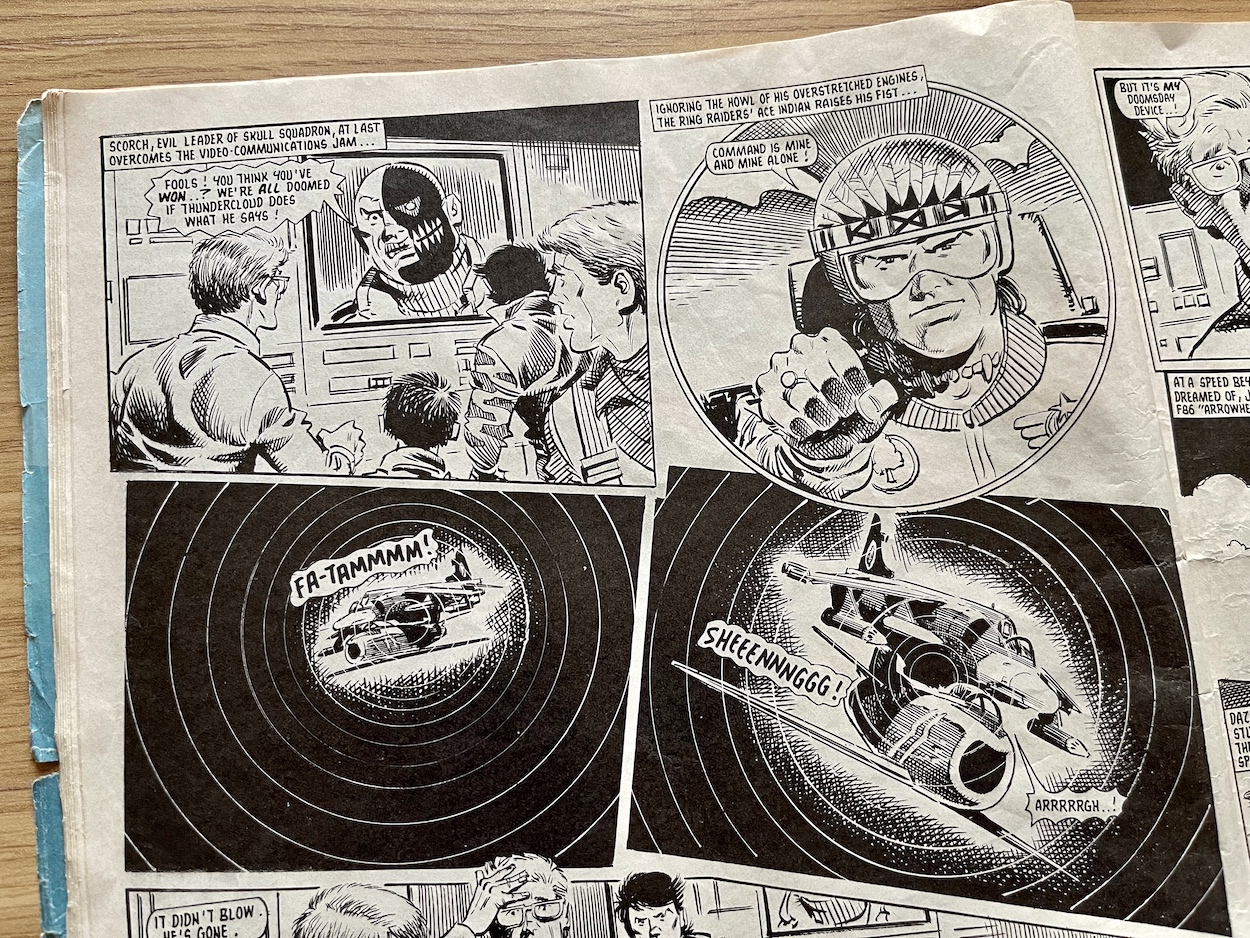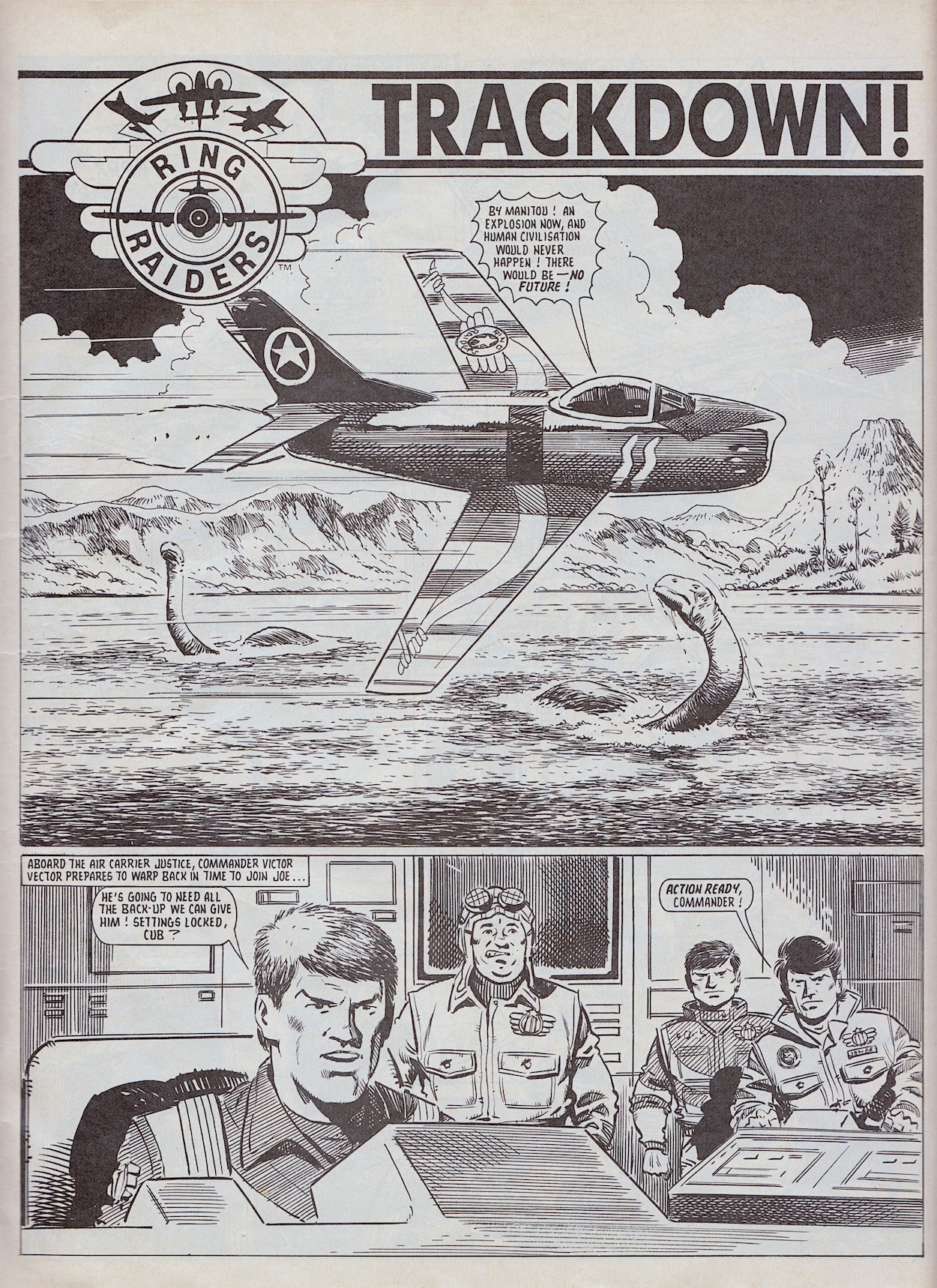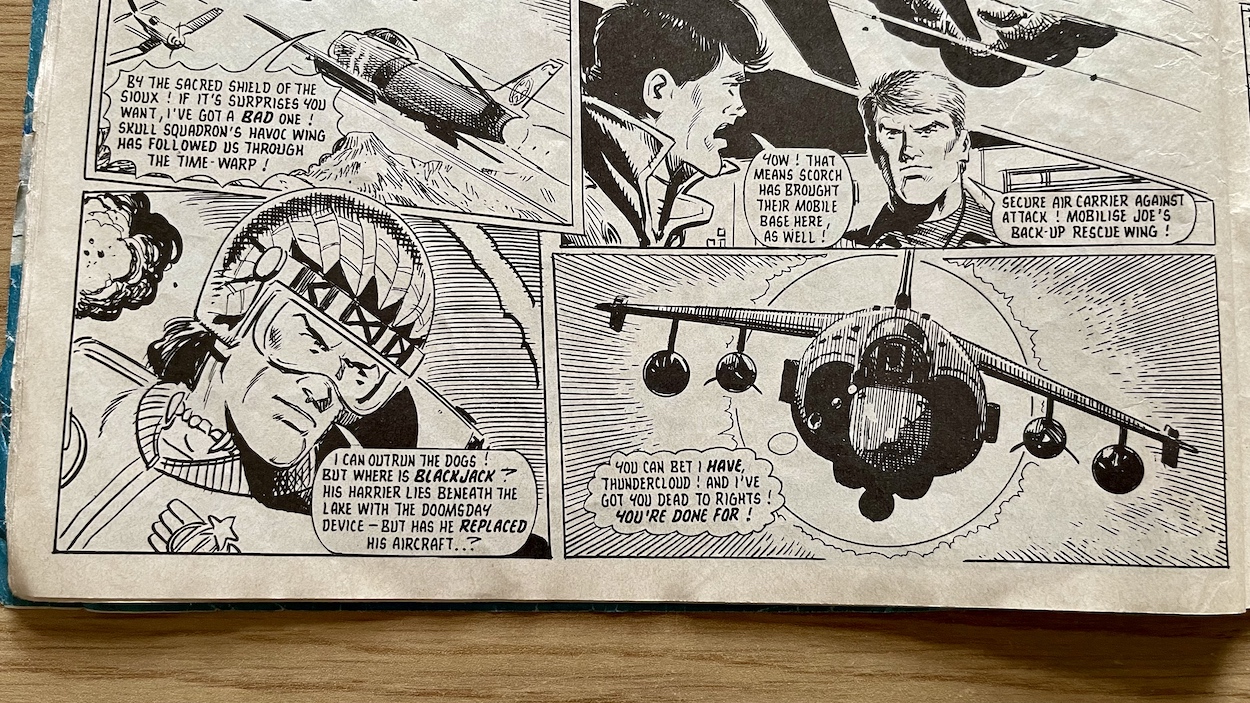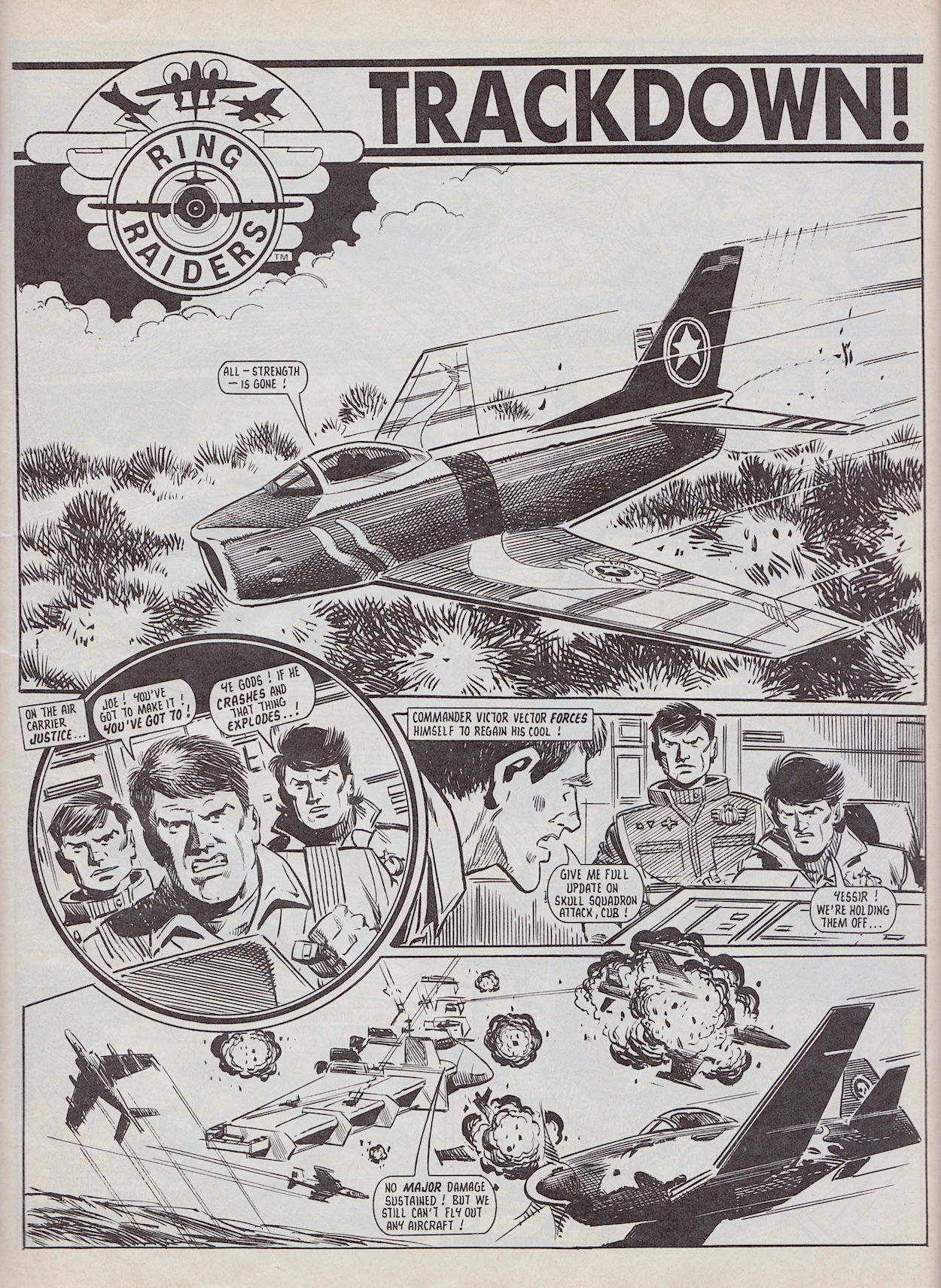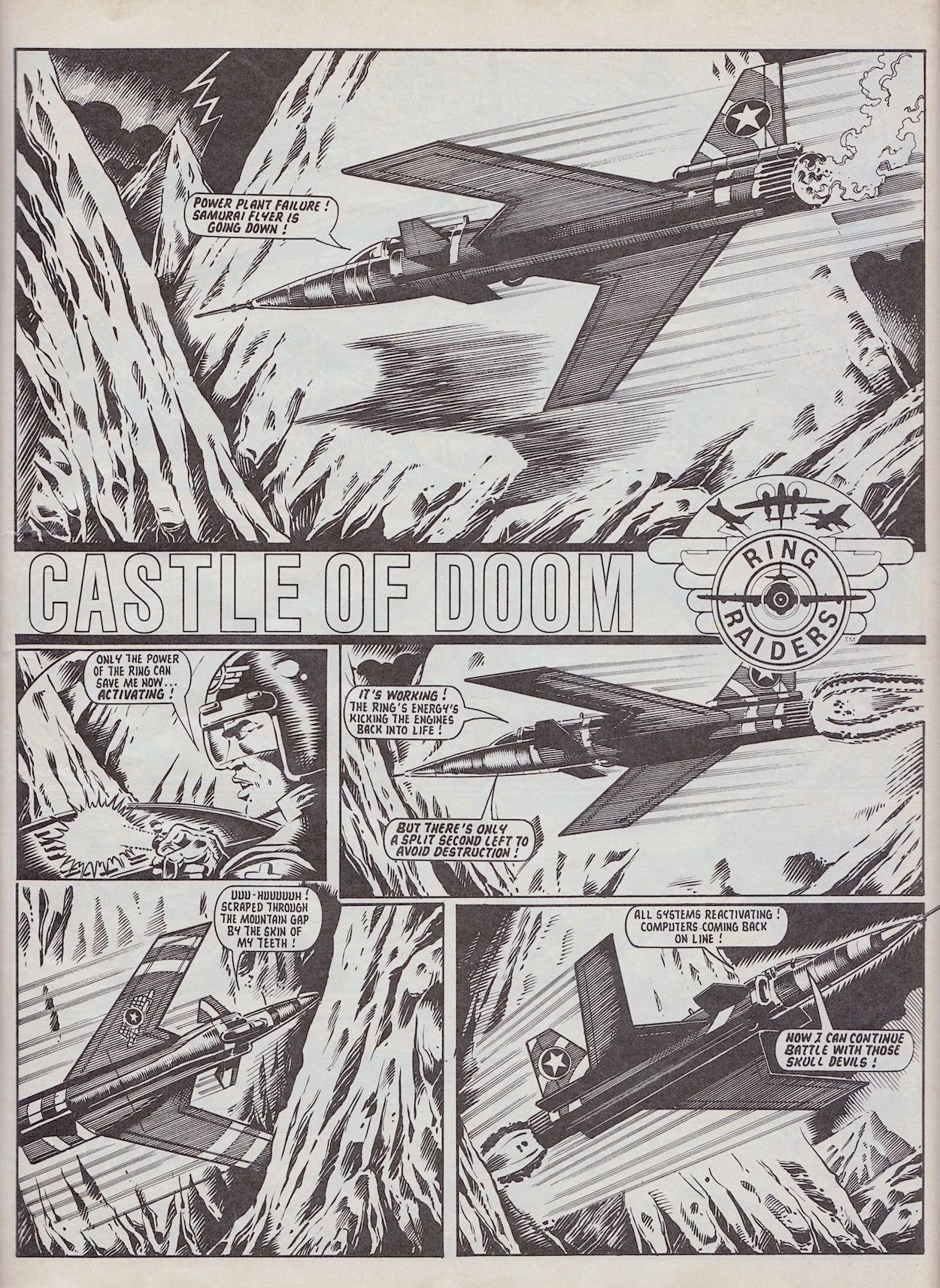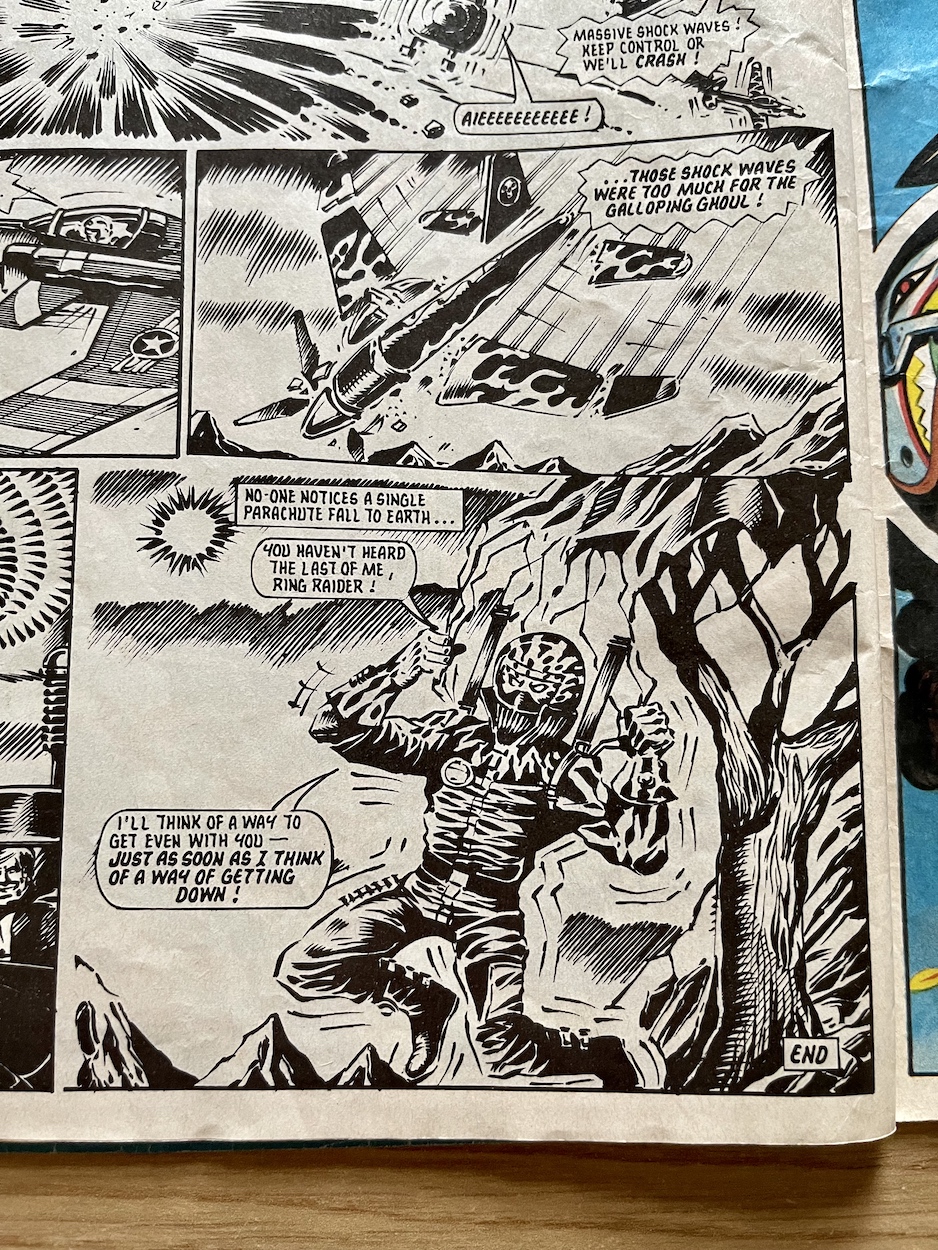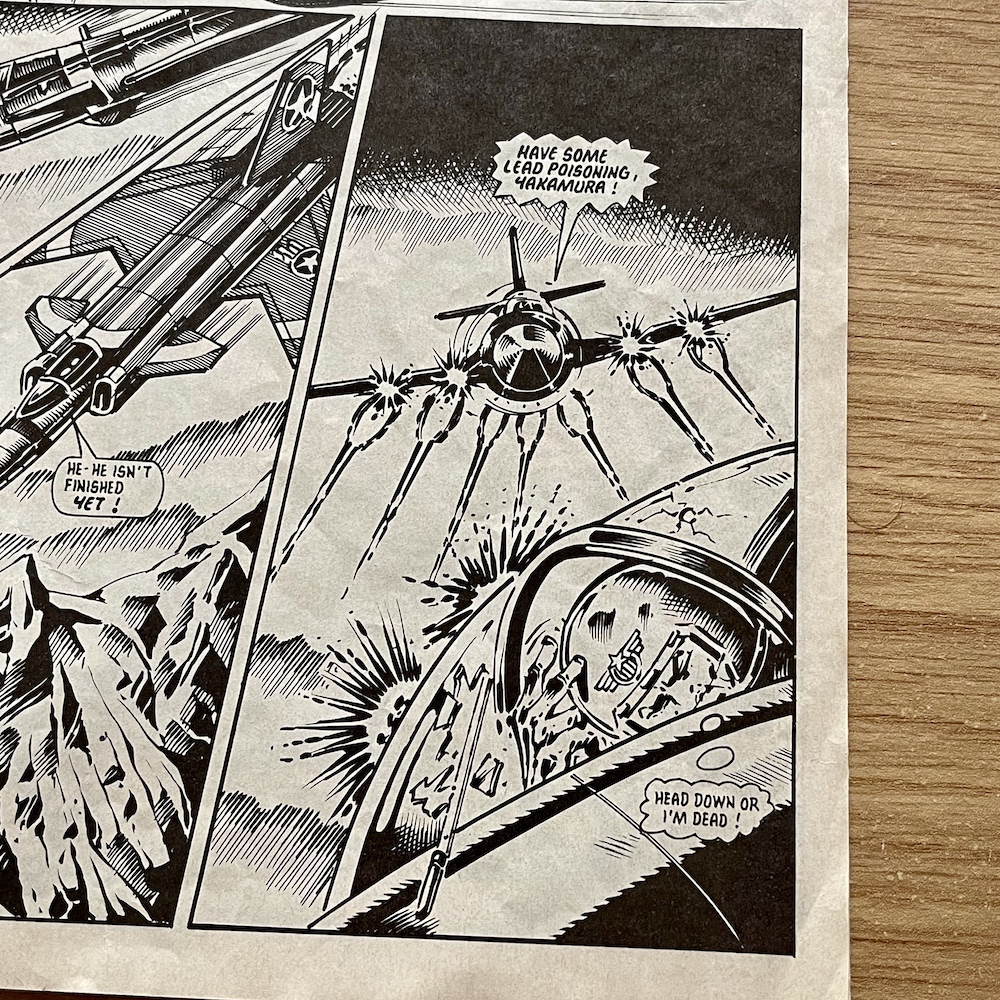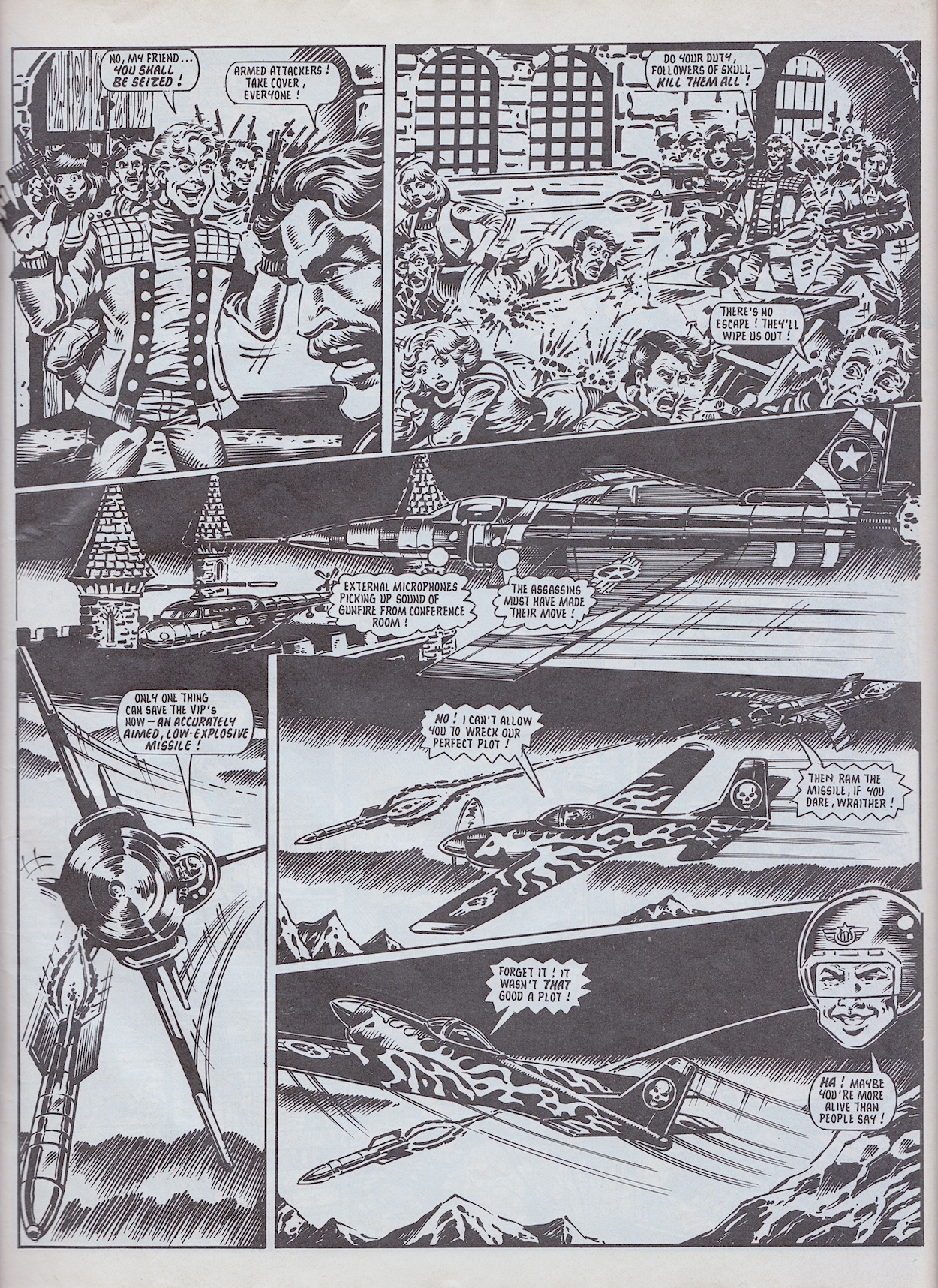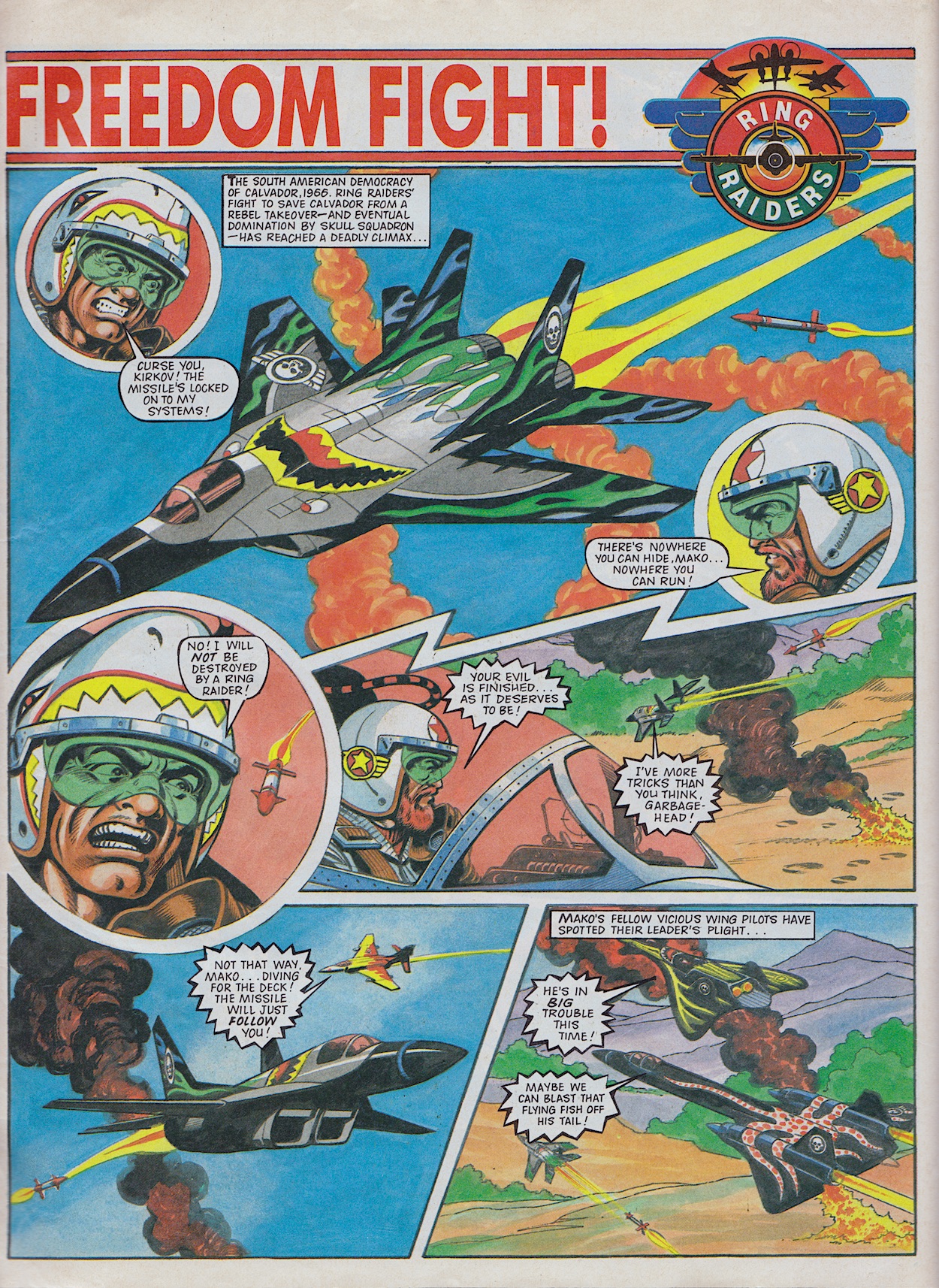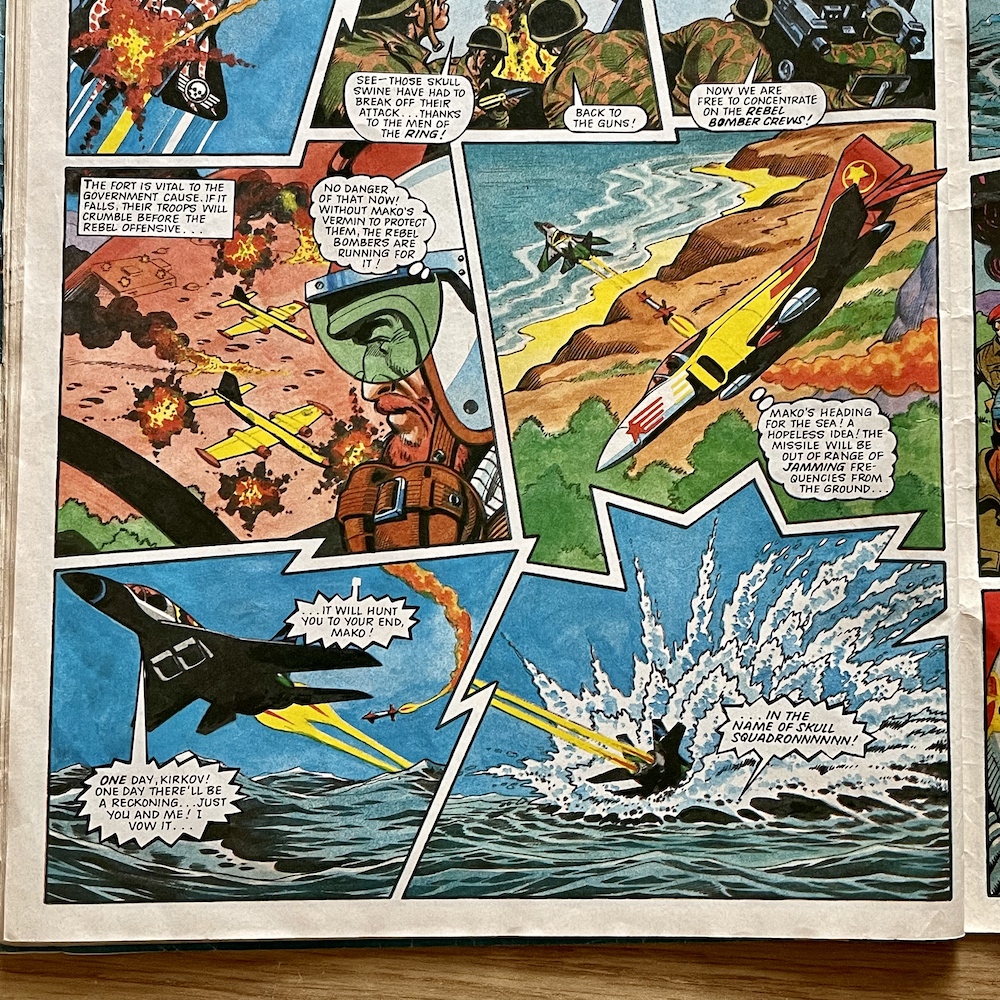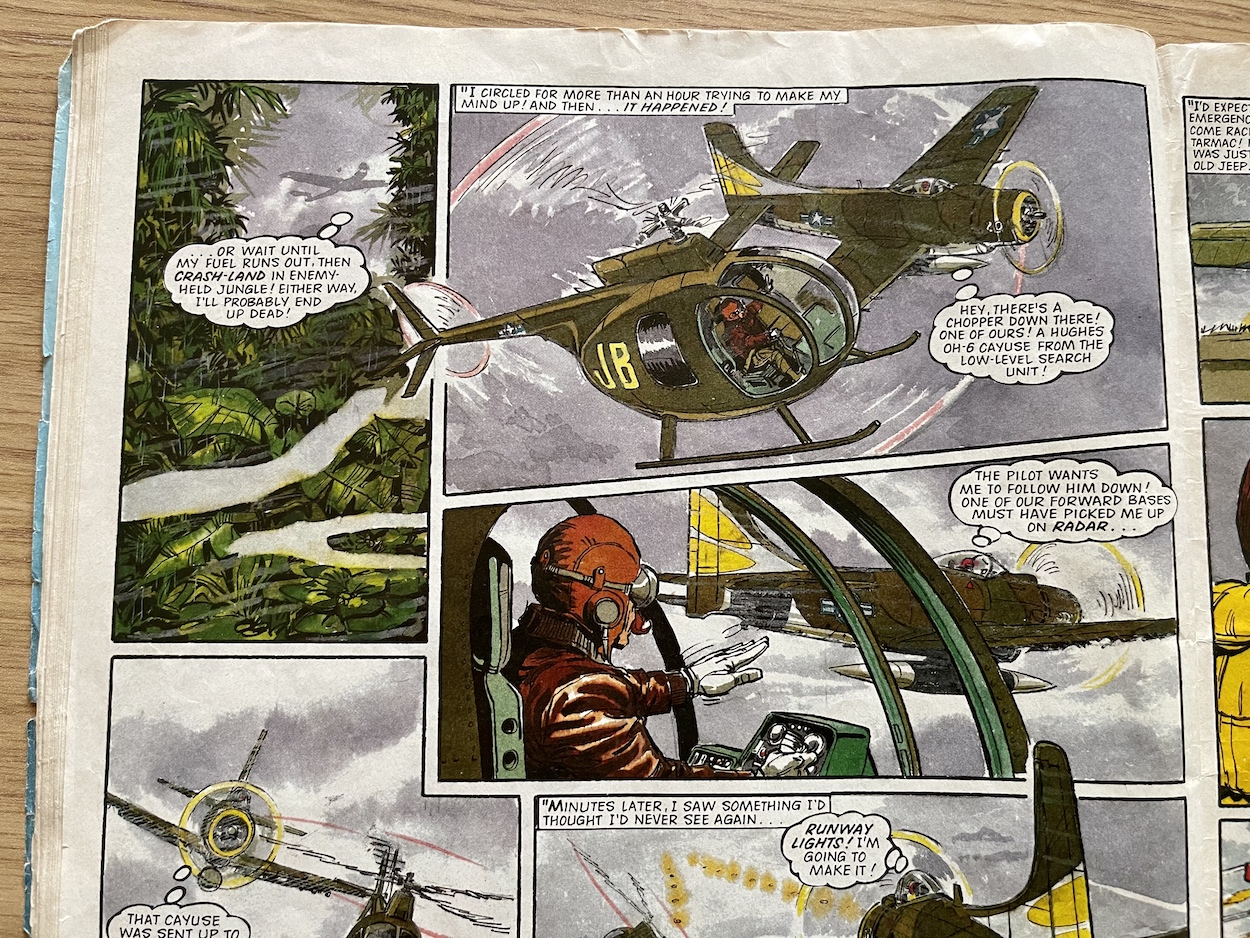The almighty trinity of 80s TV shows for me were Knight Rider, Airwolf and The A-Team. A finer trilogy of series would be hard to find. With Michael and K.I.T.T. already enjoying their own yearly real time read through it’s time to move on to Stringfellow Hawke, Dominic Santini, Michael Coldsmith-Briggs III aka Archangel and their supersonic hi-tech helicopter, Airwolf. Unfortunately there was only ever one Airwolf Annual, released for Christmas 1985. Is it a goodie?
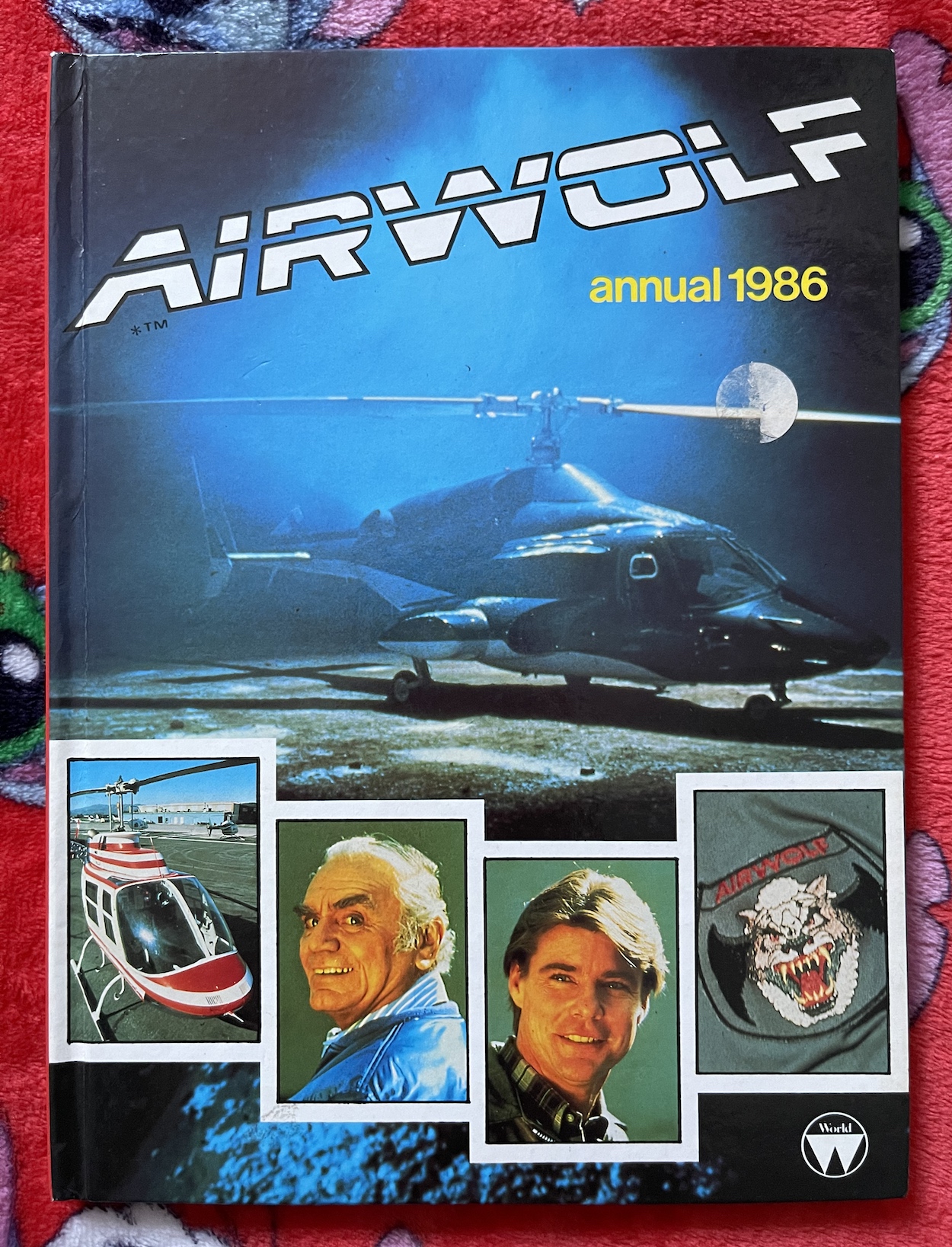
Unlike the majority of licenced annuals I read as a kid this one wasn’t produced by Grandreams or Marvel and instead was published by World International Publishing. I recognise the logo but am unaware if I ever owned any of their annuals to gleam what this might be like in comparison to Grandreams’ Knight Rider books for example, so the only way to find out is to nose dive right in.
The opening spread is a good start, with a rare behind-the-scenes photograph from the series. Airwolf itself (or “herself” as the characters would have said) was a gorgeous piece of production design. Underneath it all is a standard Bell 222A chopper, not that you could tell! A few years before Airwolf, Dan O’Bannon, the writer of the Blue Thunder movie described his helicopter as a “fast, black wasp” in his script, then described what appeared on the screen as a standard helicopter with a whole bunch of crap hanging off it.

Airwolf definitely fitted his original description much better. The idea behind it was a wolf in sheep’s clothing (hence the uniform patch you can see on the cover). It was meant to look like an executive helicopter until battle commenced, when guns and missile launchers would slide out, and inside was a control centre full of technology for use on covert operations that made us 80s kids drool.
The book kicks off with a quick two-page fact-file feature. It’s not brilliantly designed but does include the introduction used as part of the opening credits in season one and a word-for-word recreation of Marella’s (Archangel’s top assistant from The Firm) description of Airwolf from the pilot movie. Well, it’s almost word-for-word. Apparently the original ending of “Airwolf is a Mach 1+ chopper that can kick butt” was too much for the annual. Really?
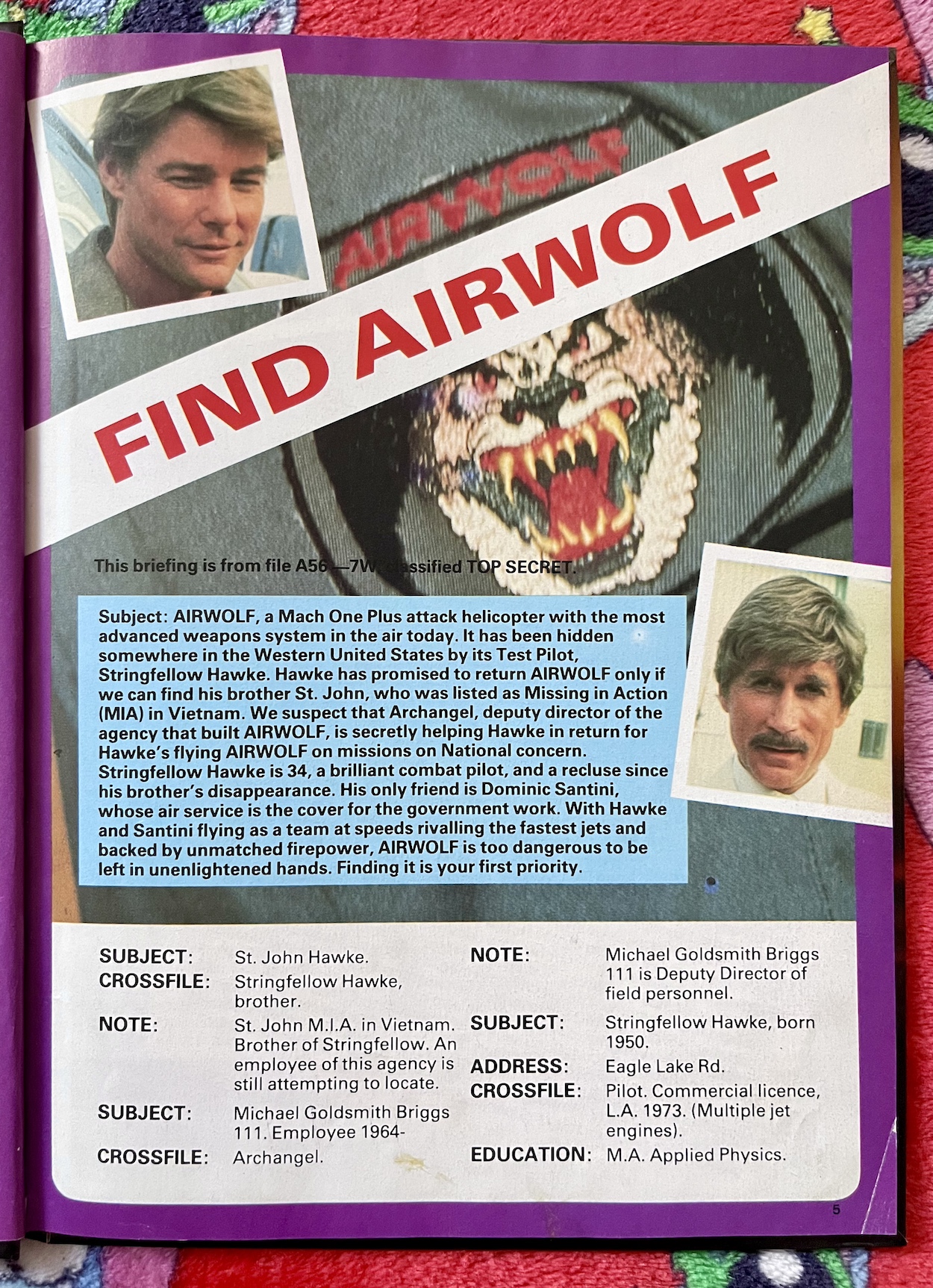
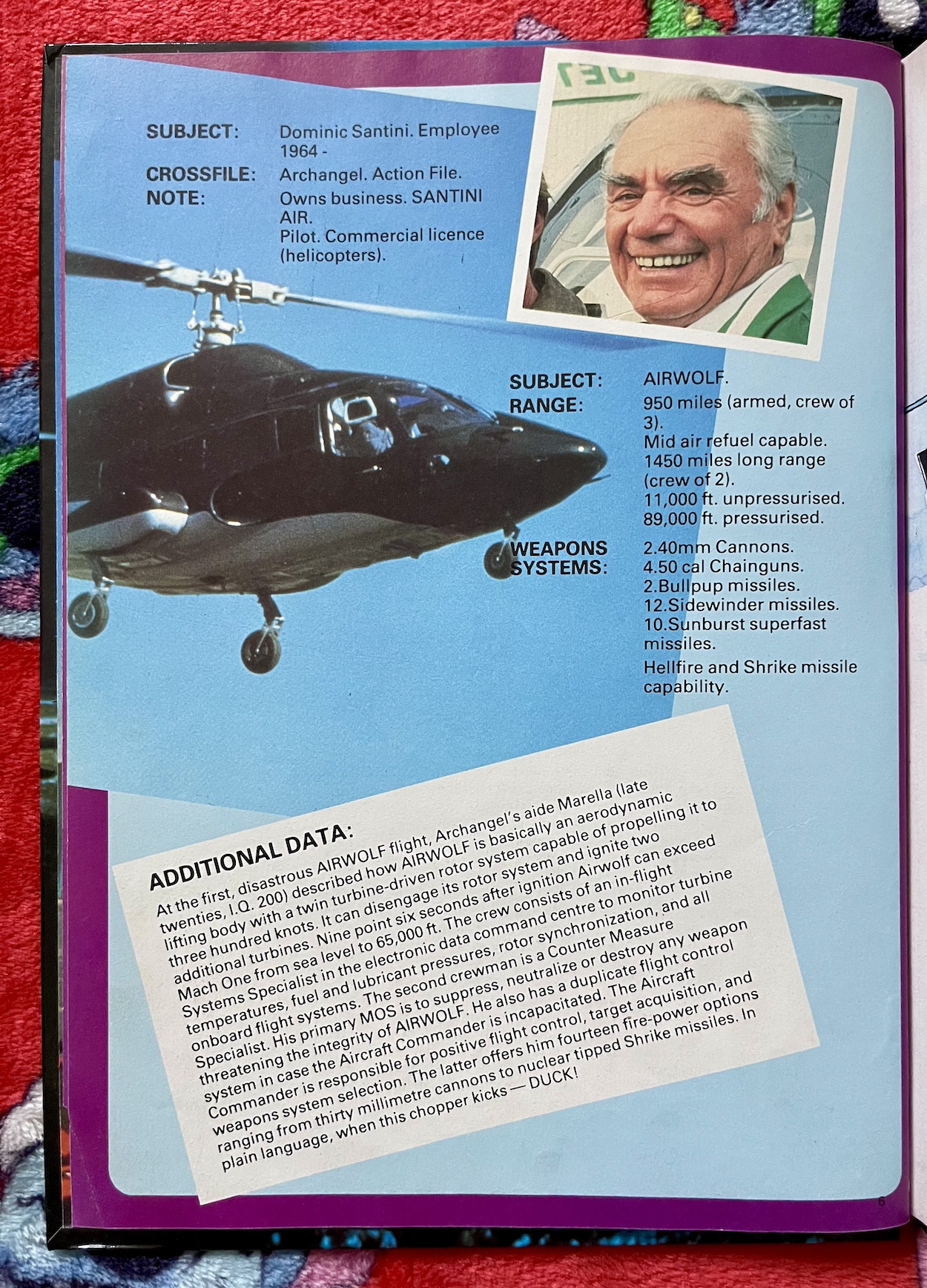
Unlike the Knight Rider annuals which had a pretty even mix of gorgeous comic strips and prose stories, pin-ups, interviews and behind-the-scenes features, Airwolf’s annual is more basic in its list of contents. One lone strip is accompanied by no less than seven text stories. There are a small handful of pin-ups, a basic board game, a helicopter name wordsearch and a two-page look at some other helicopters from the real world (not exactly ‘exclusive’ content).
So yes, the prose stories are the main (turbo) thrust of this book and in general they’re very good, each one reading like the final act of a really enjoyable episode. There is a big caveat with that though, which we’ll get to in a bit. Unfortunately there’s no indiction inside the book of who wrote these. Whoever it was seems to have had a good handle on the show, at least the first season which was probably all that had been shown in the UK when this was written well in advance of its publication date.
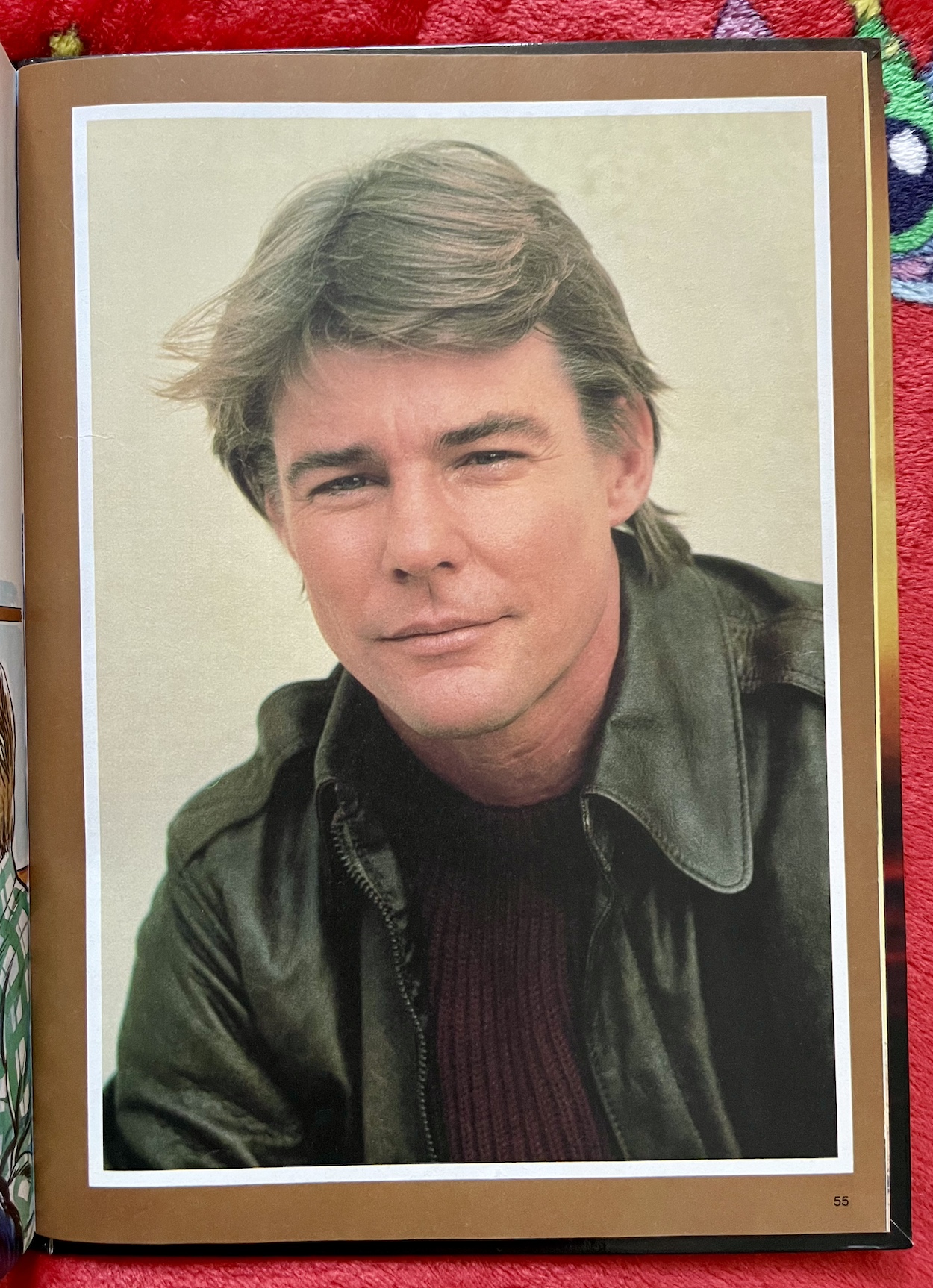
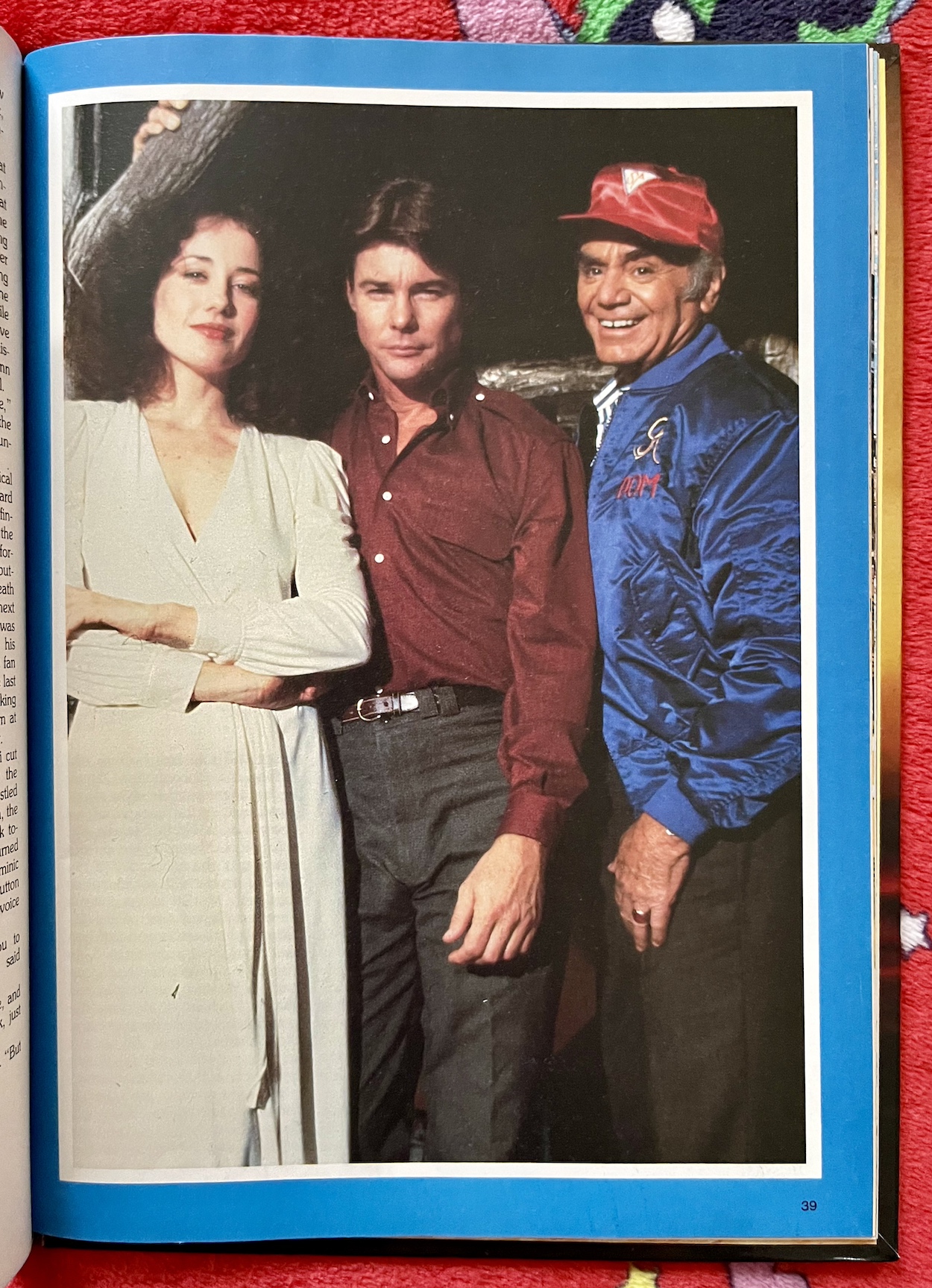
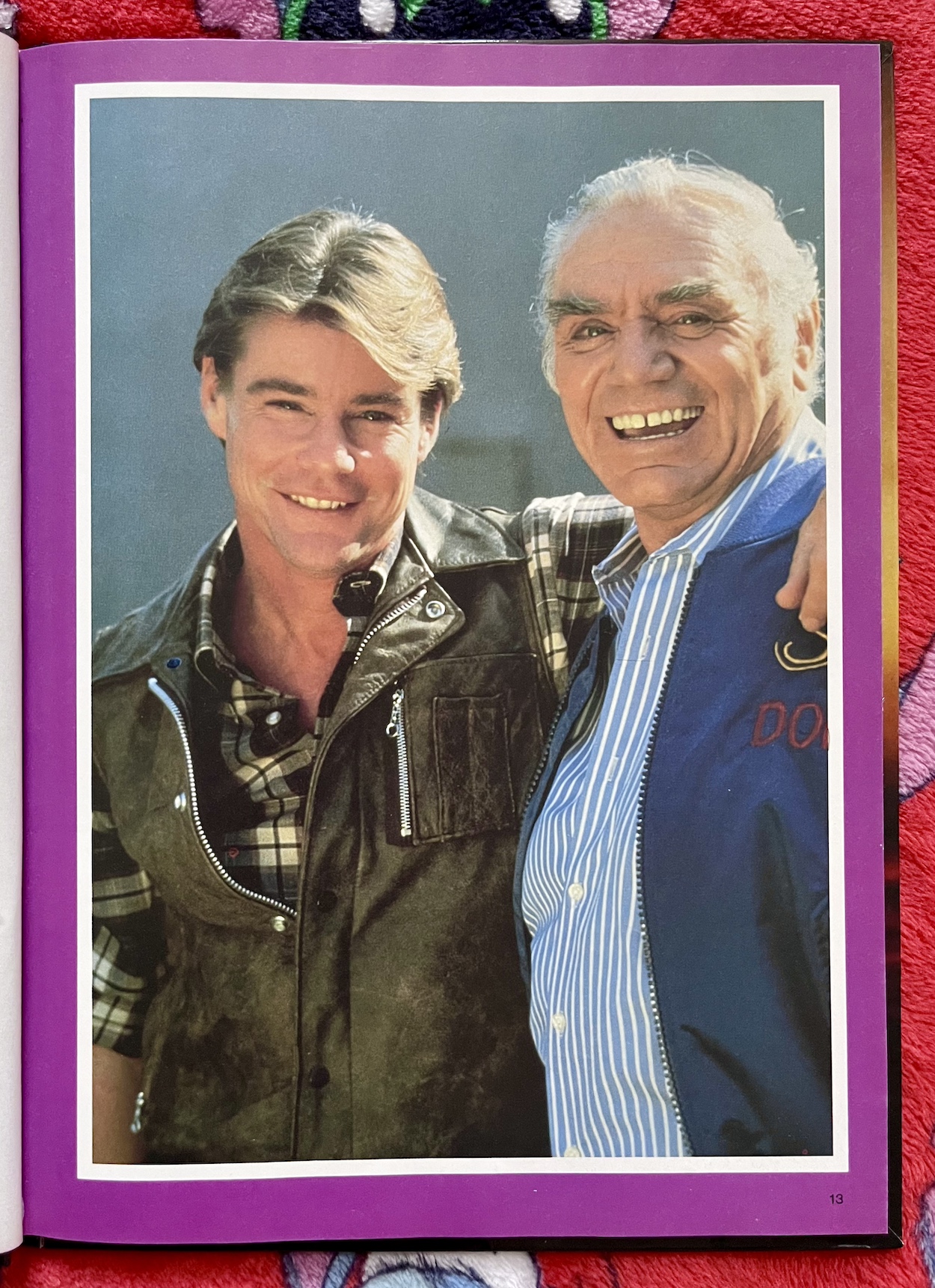
The best two stories are A Hostage to the Storm and Border Incident. The former is the first in the book so we’re off to a great start. It has an interesting setup in which the cargo ship Galveston Star makes its way through a buffeting storm, described as a vessel procured by a mysterious man called Robert Hughes, who paid off the shipping company’s $10 million loan in return for registering his ship with them. Apparently used to shift tractor spares around the world no one has ever been able to confirm this.
In reality Robert Hughes is Archangel and the Galveston Star is used to ferry Airwolf to far off countries, kind of like how the semi-trailer truck transported K.I.T.T. in Knight Rider. I love this idea and wish the series itself had implemented it. The Firm has lost contact with a weapons satellite and are taking its creator, Professor Viljoen to Angola where he’ll go up in Airwolf to try to reestablish contact before it falls into enemy hands. Except, it’s all a ruse.
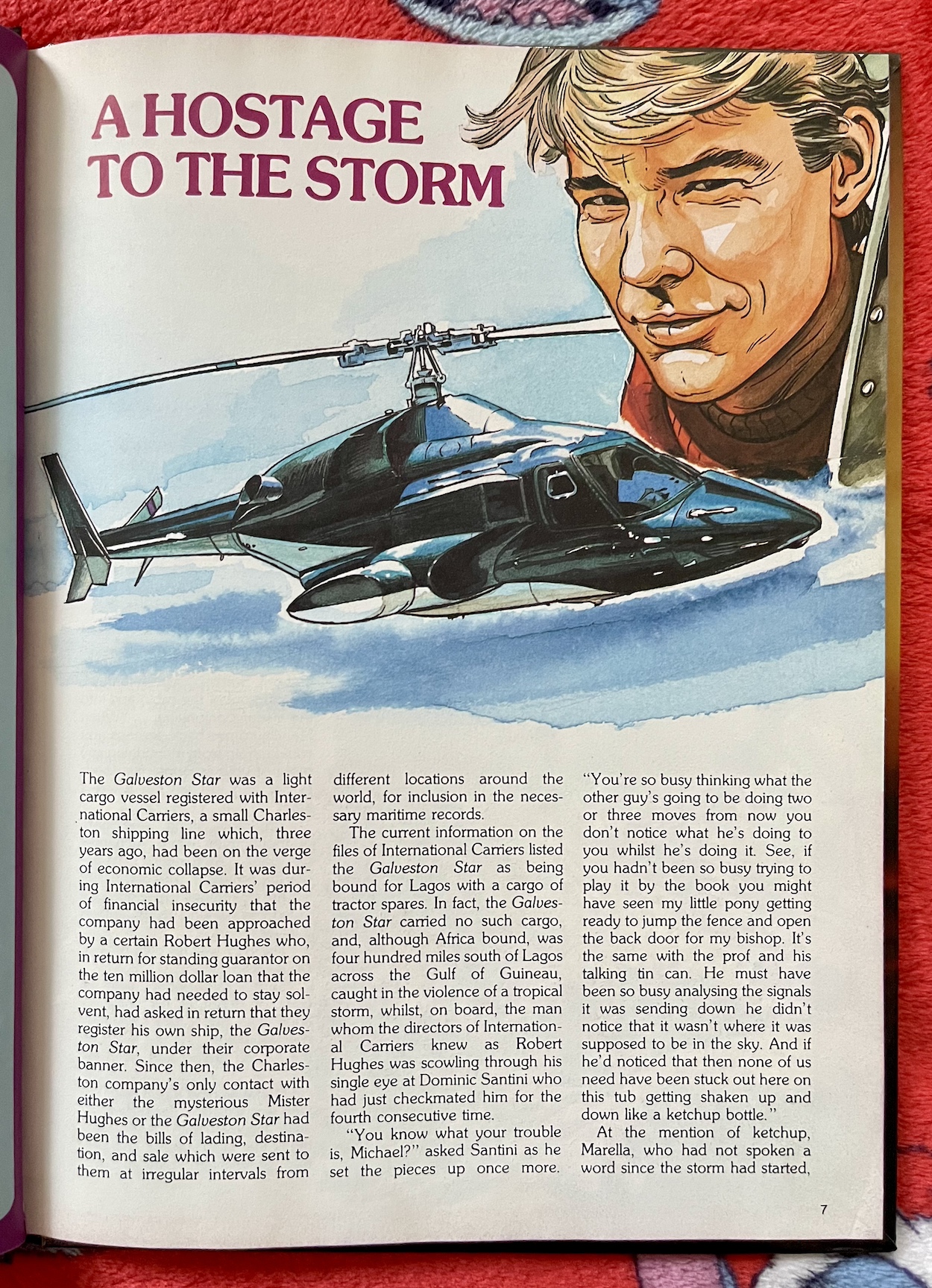
The Professor’s son has been missing since Vietnam and he’s exhausted all his options to find him. Even the government seems to have given up. He thought once The Firm was in Angola where he’d safely landed the satellite (after finding out his son had been taken there) and he told them his story, they’d have no choice but to help a desperate father. Of course Archangel fumes about the betrayal but String and Dom think they can help.
The scene is something the show just wouldn’t have been able to reproduce, so it’s exactly the kind of thing fans would love to read
With Angola, Cuba and Russia all involved in the plot the writer is very familiar with the Cold War stories of the show’s first year. There are also plenty of great character interactions, everyone acting just as they would on TV, especially our Airwolf crew’s patter and the way they’re able to manipulate Archangel into doing the right thing. There’s also a thrilling take off from the cargo bay of the ship in the middle of the storm, the ship swaying wildly while Hawke expertly counters the movements as they hover inside the ship and finally take Airwolf out into the safety of the sky.
The only real problem here is the choice of images to illustrate the story. The scene I’ve just described in particular is something the show just wouldn’t have been able to reproduce, so it’s exactly the kind of thing fans would love to read. However, it’s illustrated with a rather bland image of Airwolf moving away from the ship with Archangel and Marella apparently watching. I say apparently, because we only see them from the back.
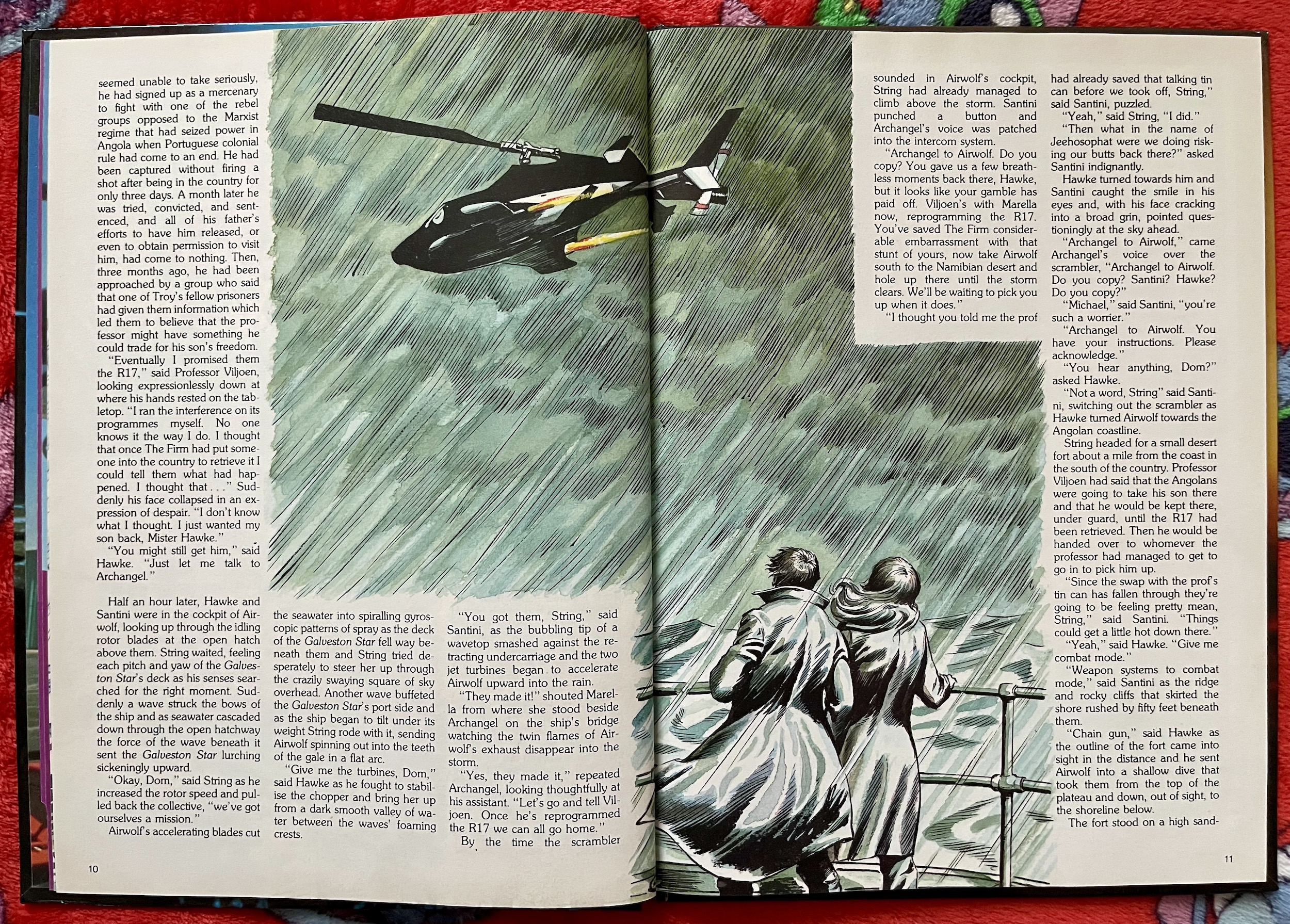
This leads me on to the main problem with the annual, the art illustrating the prose stories. Any images of the characters or of Airwolf itself are copied straight from stills of the show, as if they’ve been traced from a television screen. With every single image I could point you towards the episode and scene in question (I’m a huge fan if you hadn’t guessed) that has been passed off as original art. It’s like an 80s version of terrible A.I. art.
It means very few of the illustrations relate to the plots of the stories. Any that are original are pretty poor and have as little detail in them as possible, such as above with characters facing away. In another drawing in the book String, Archangel and Marella are recoiling from an explosion and they all just happen to have their hands covering their faces so the artist doesn’t have to draw them. Although, you can see enough of Marella to see she’s been portrayed as a white woman! This is just laziness (and offensive).
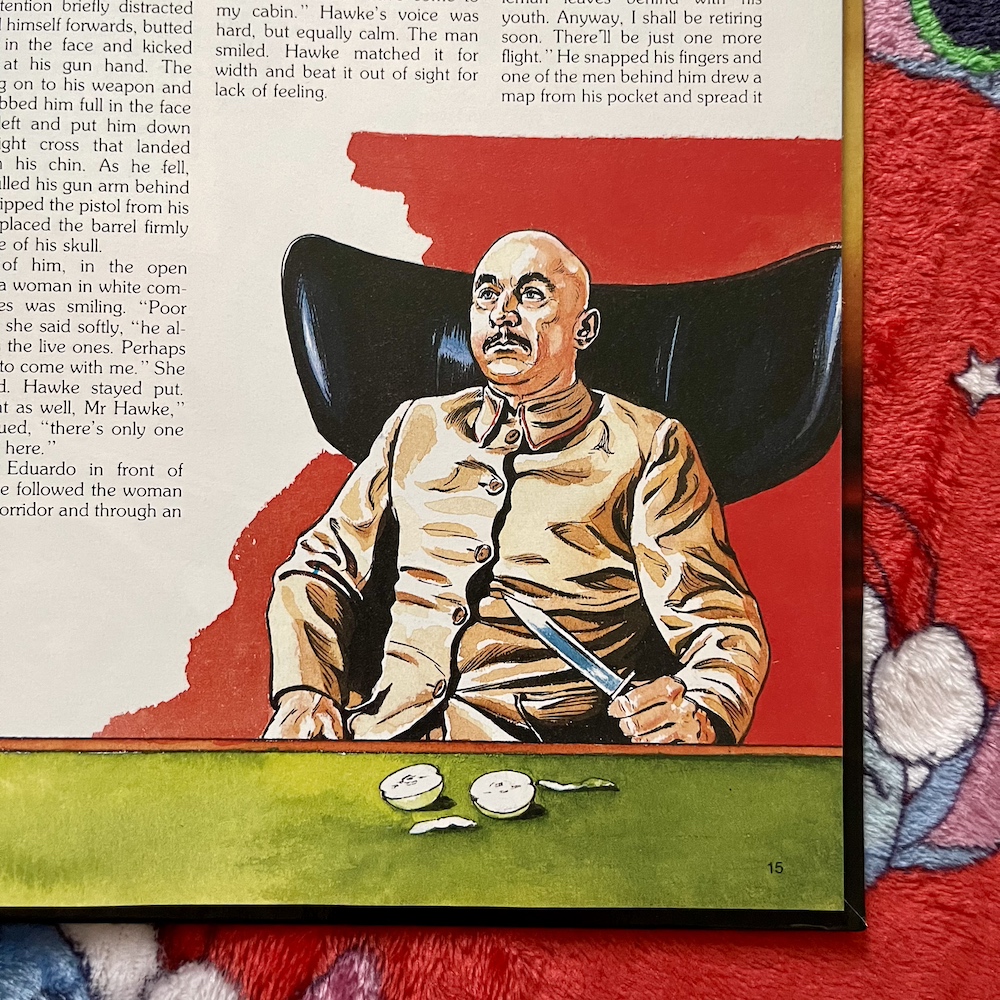

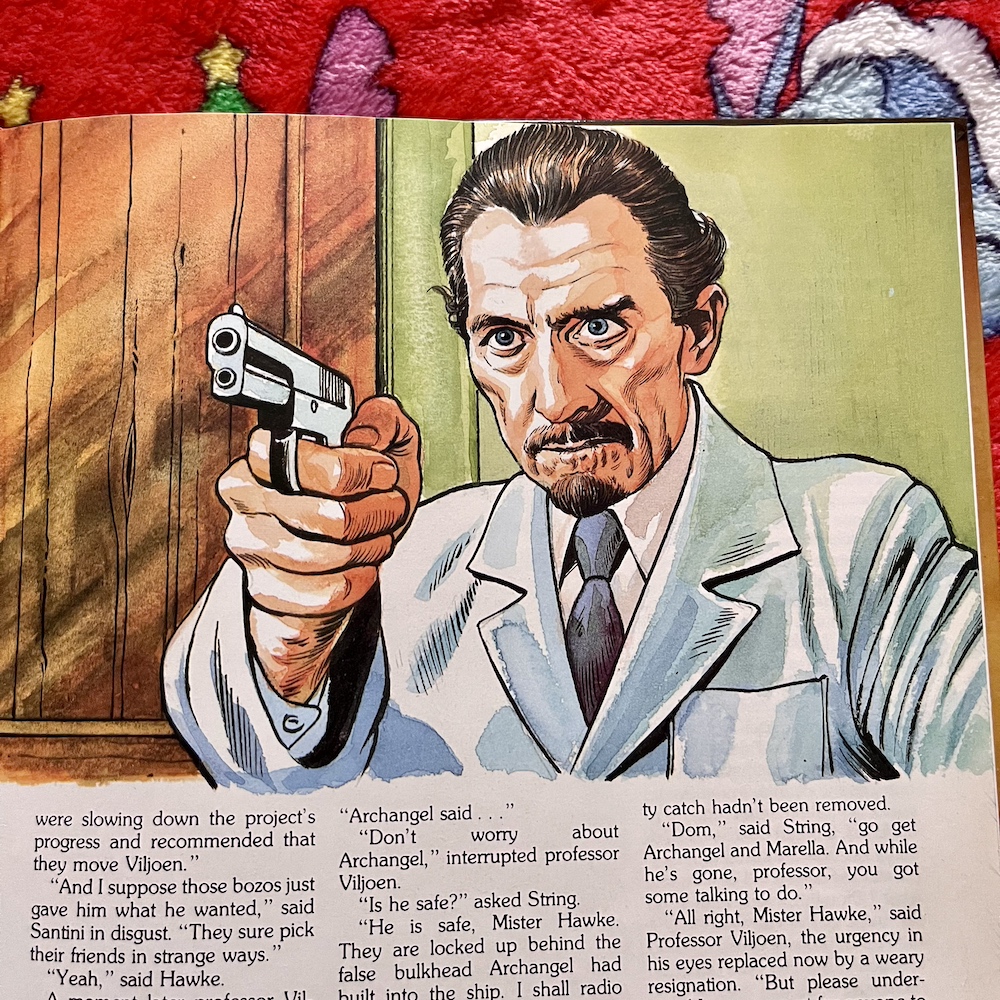
Then we get to the villains. Obviously these are original characters so surely they have to be drawn properly? Have a look at these three examples. No, I didn’t realise Donald Pleasance‘s Blofeld, Gert Frobe‘s Goldfinger or Peter Cushing were all Airwolf characters either. (Thanks to David Leach for helping me name Peter here, he was on the tip of my tongue!)
For a show that was so visual, that had such incredible aerial photography, the annual falls drastically short in this regard. The artist chosen to illustrate the vast majority of a book based on such a TV show seems to be completely out of their depth. Thankfully renowned IPC/Fleetway artist Sandy James steps in for the six-page comic strip tucked away in the middle of the book, called Snow to Eskimos. However, it appears even one of my favourite Ring Raiders artists isn’t that familiar with the source material either.

This first image brought me a lot of hope. Despite Airwolf being completely the wrong colour at least it looks like itself and Sandy hasn’t resorted to copying images from the show. However, as fans will see below, it all goes downhill from there. What is that interior all about when the missiles are actually launched from the flight stick? Since when did Airwolf have DeLorean doors? Where is Archangel’s eye patch?
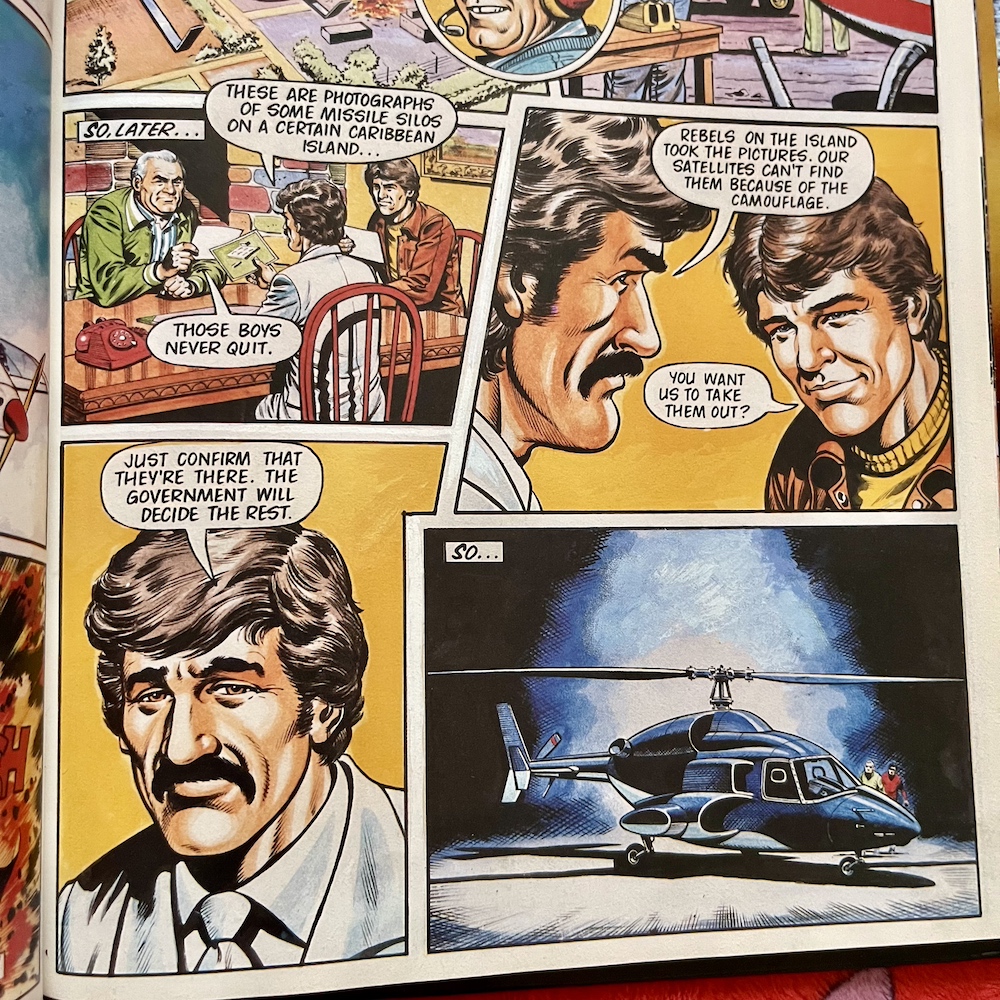

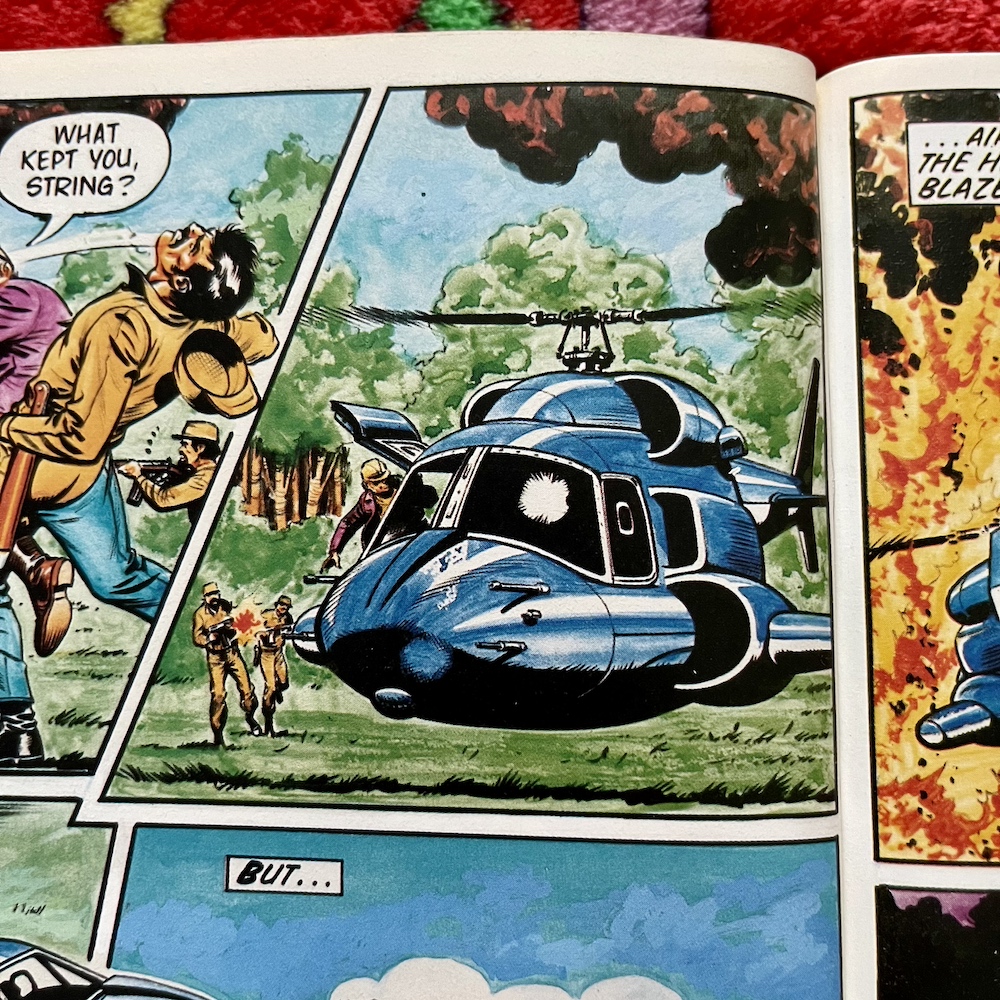
That last panel in particular makes me think Sandy had never seen the show, which is fair enough, but after David Lloyd told me all about the research he did in order to draw the Knight Rider annuals it’s very disappointing. If Sandy was only working from a script then it was clearly written by someone also unfamiliar the show. It’s a truly terrible script, with dull, robotic dialogue and little of consequence happening.
Clearly it wasn’t written by whoever wrote the prose stories, who definitely knew their stuff! Let’s have a quick run through the others before I tell you more about my second favourite.
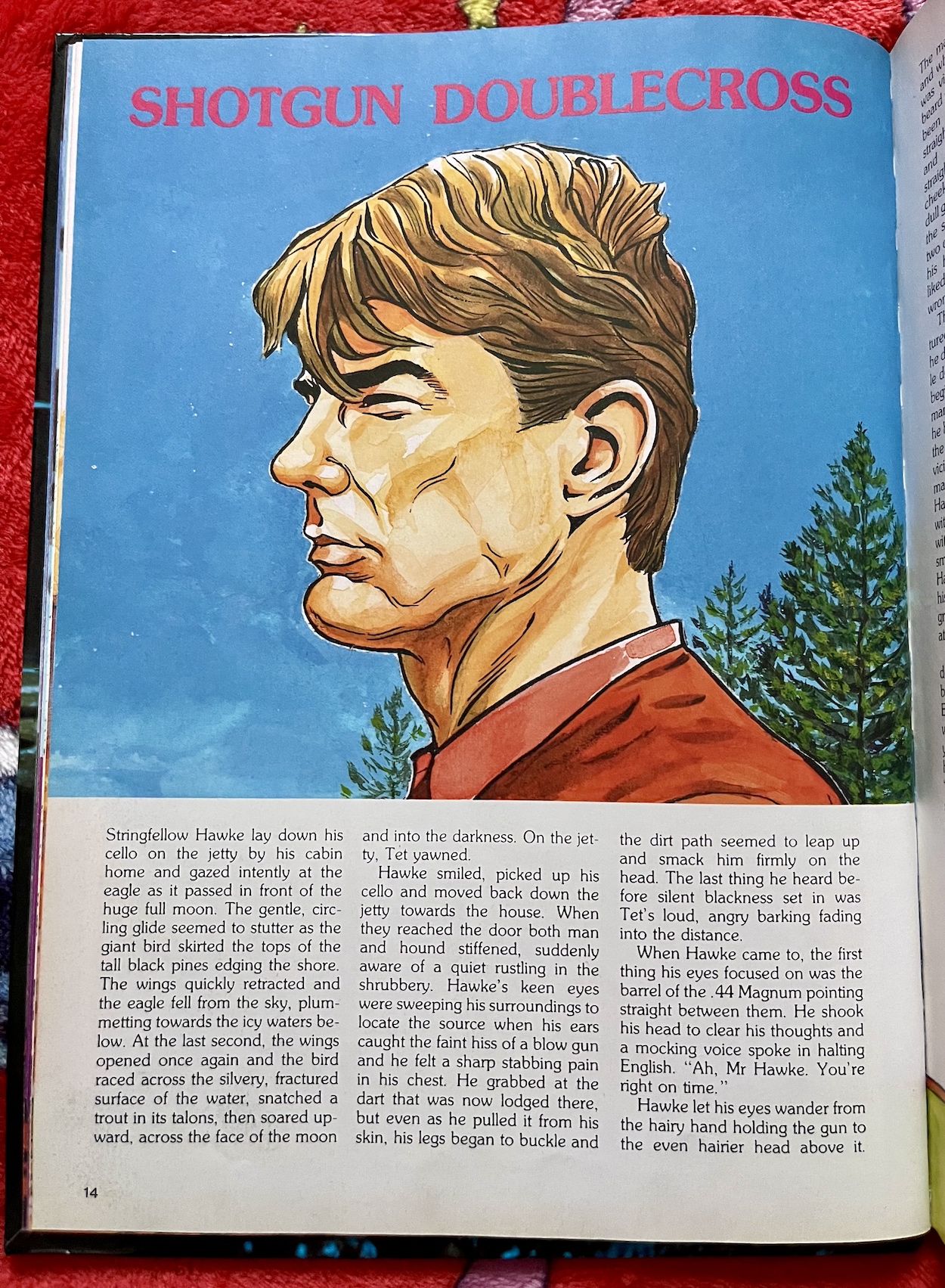

Shotgun Doublecross starts with all of the key Airwolf visuals. The cabin. The lake. The eagle. The cello. Tet the dog. Hawke’s insanely good hearing. He’s kidnapped from his home and told he must use Airwolf to help traffic some planes across Mexican airspace for a cartel because his long-lost brother Sinjin is also on board. He goes up against The Firm for this one and there’s some great dialogue between the key players. You can almost hear the actors saying their lines.
Desert Death Trap is a basic rescue mission story but is imaginatively portrayed, the action playing out just like one of the show’s thrilling dogfights, painting exciting pictures in the readers’ heads (to make up for the ones on the page). Flames Over the Water revisits the death of Hawke’s family on the lake, something only touched upon in the pilot movie. The opening page in particular is surprisingly beautifully written for an annual.

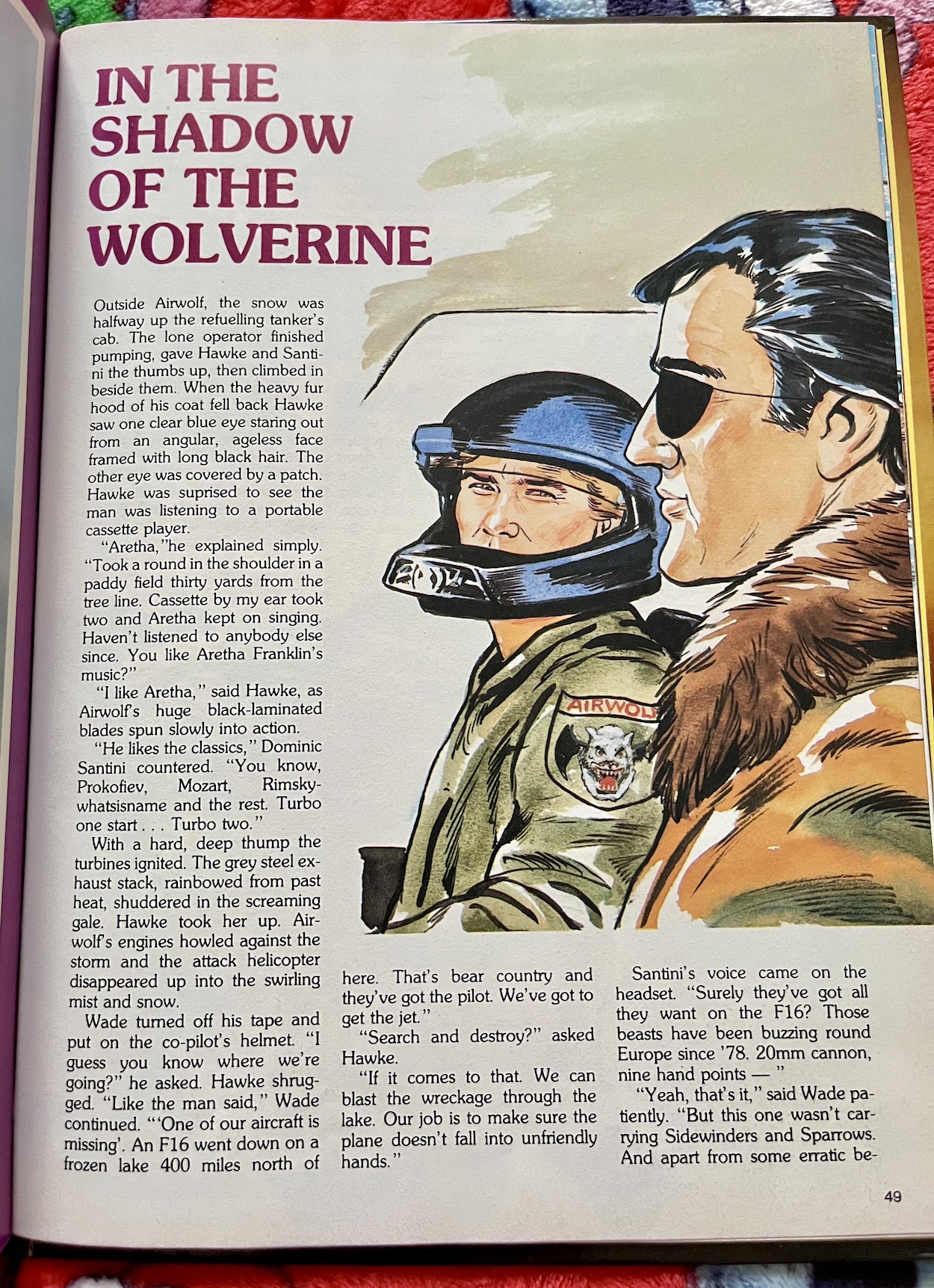
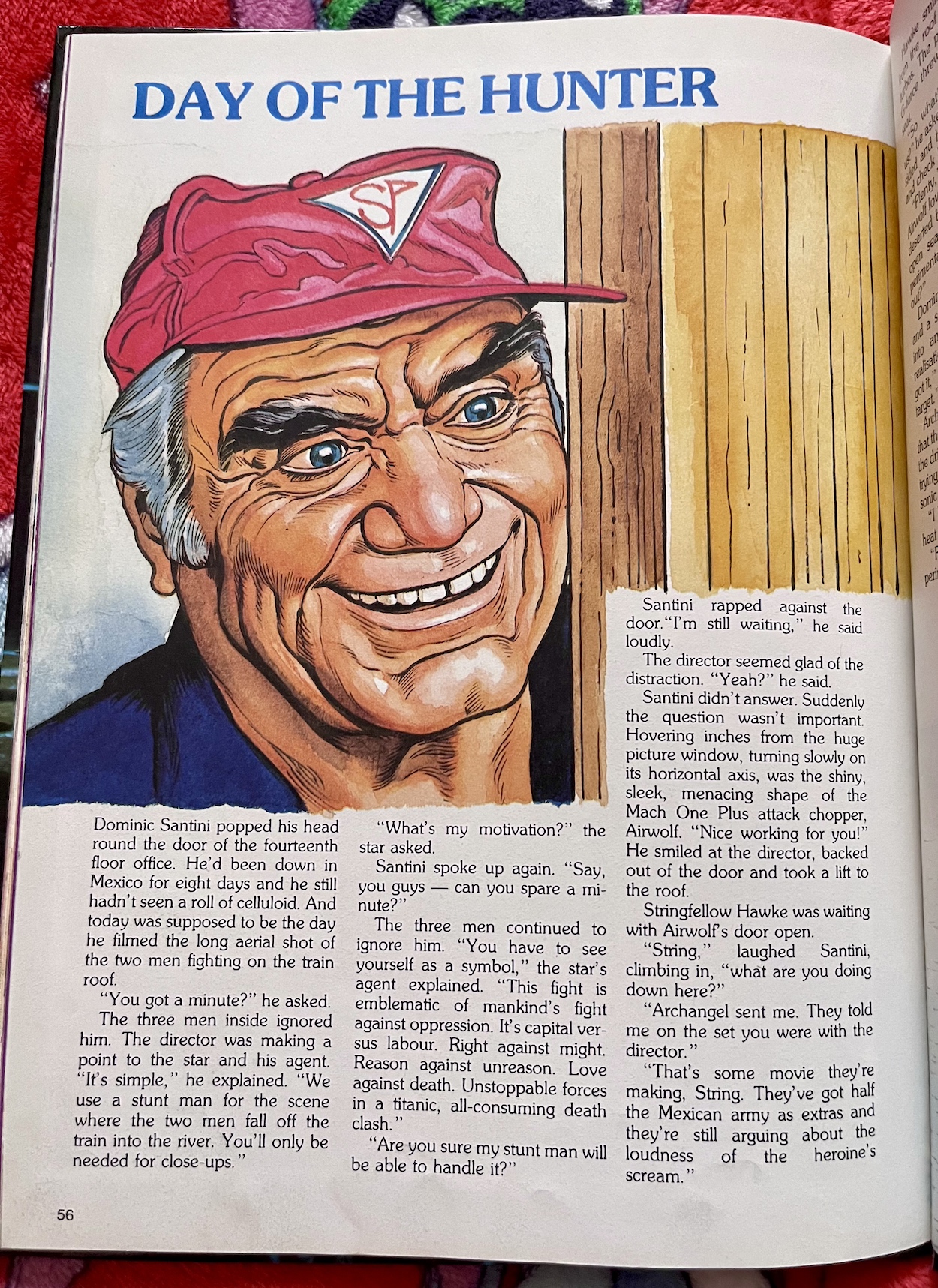
The so-called villain of the piece is seeking revenge on the US because of the death of his one true love by indiscriminate American bombing campaigns, placing the Airwolf crew in a more sympathetic position. In the Shadow of the Wolverine involves a covert op for The Firm gone wrong, a Cold War prisoner swap in a blizzard and a brilliantly written character whose allegiances kept me guessing to the very end.
It paints a wonderful picture of serenity when the cabin didn’t feel like an isolated place but was instead full of warmth and love
Then there’s Day of the Hunter which is a very silly story right at the back of the book, so unfortunately the whole thing ends on a low note. Believe it or not it involves Airwolf, a train and another helicopter all inside a train tunnel. No, really! If the rest of the prose stories feel like grittier season one fare, this is straight out of the fourth season. Fans will know what I mean by that.
But back to that other story I’d listed as a favourite. Border Incident kicks off with Dom reminiscing about happier times, when all of the Hawke family were alive, happy and at home. It paints a wonderful picture of serenity when the cabin didn’t feel like an isolated place but was instead full of warmth and love, and the portrayals of String and Sinjin as children are both funny and feel completely accurate even though we never saw their younger selves on the show.
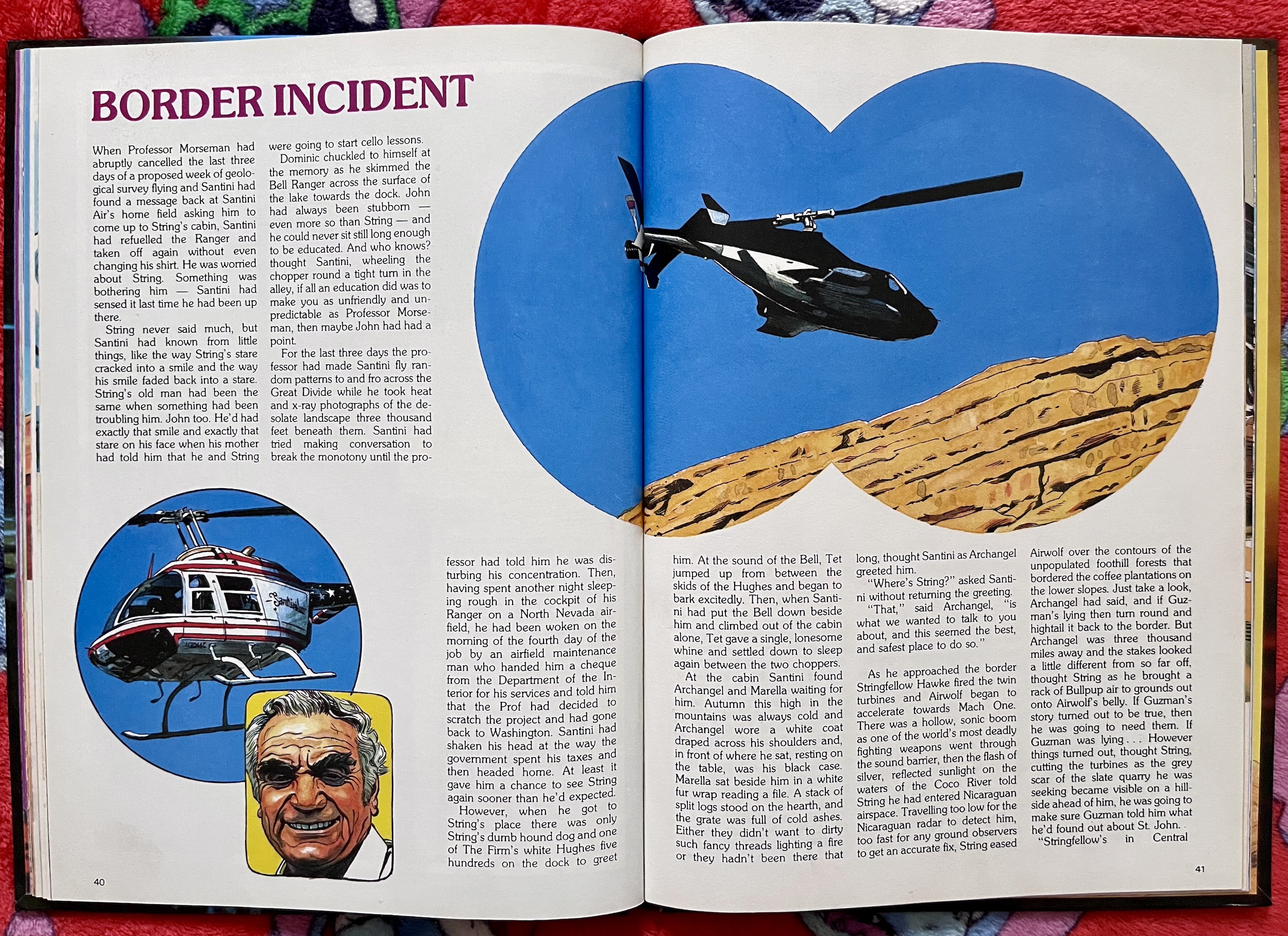
String has taken Airwolf on a mission alone. Now, fans will instantly think this isn’t possible, Airwolf needs at least a two-person crew. Unfortunately there’s no explanation of how that’s achievable, and some of the ‘copters abilities used here would be impossible without Dom being in the rear cabin. But we’ll forget about that and put it down to a simple misunderstanding on the part of the writer because the rest of the story is fantastic.
It’s an uncharacteristic but deliberate decision by String, setting the reader on edge right from the off. As it turns out this particular mission once again involves the possibility of Sinjin being found, but String was doubtful about the source of the information and wanted Dom to work the case from the outside, where the villain character wouldn’t be watching. Dom could go undercover and find out the truth, while being ready just in case they needed to fight their way back out.

Knowing Dom would never have allowed him to go alone he took Airwolf and then cheekily got Archangel and Marella to pick up Dom and tell him! There’s a very funny scene where Dom is ranting and raving to the two Firm operatives, not listening to a word of their explanation about the mission, until they tell him String knew he wouldn’t have allowed him to go alone. To which Dom suddenly calms down, basically says, “Yep, that’s right” and heads off on the mission!
There’s an exciting climax involving Airwolf down a booby-trapped mine shaft which again would never have been seen on TV, at least not without those very unconvincing models some of our action shows used back then. Again, there are no images to go with it, the closest being the one above of the annual’s opening image of Airwolf with some poorly drawn cliff faces around it.
After all these years I never thought I’d get to discover any new Airwolf material
In conclusion, for fans this is really a book of two halves: the writing and the art. While it’s nice to see any artwork of Airwolf these days it’s instantly forgettable, however that shouldn’t put anyone off buying it. There are no introductions for those unfamiliar with the plot of the show but for those up to speed there are six great stories here (and the other two are easily forgotten). After all these years I never thought I’d get to discover any new Airwolf material so that in and of itself has been a joy.
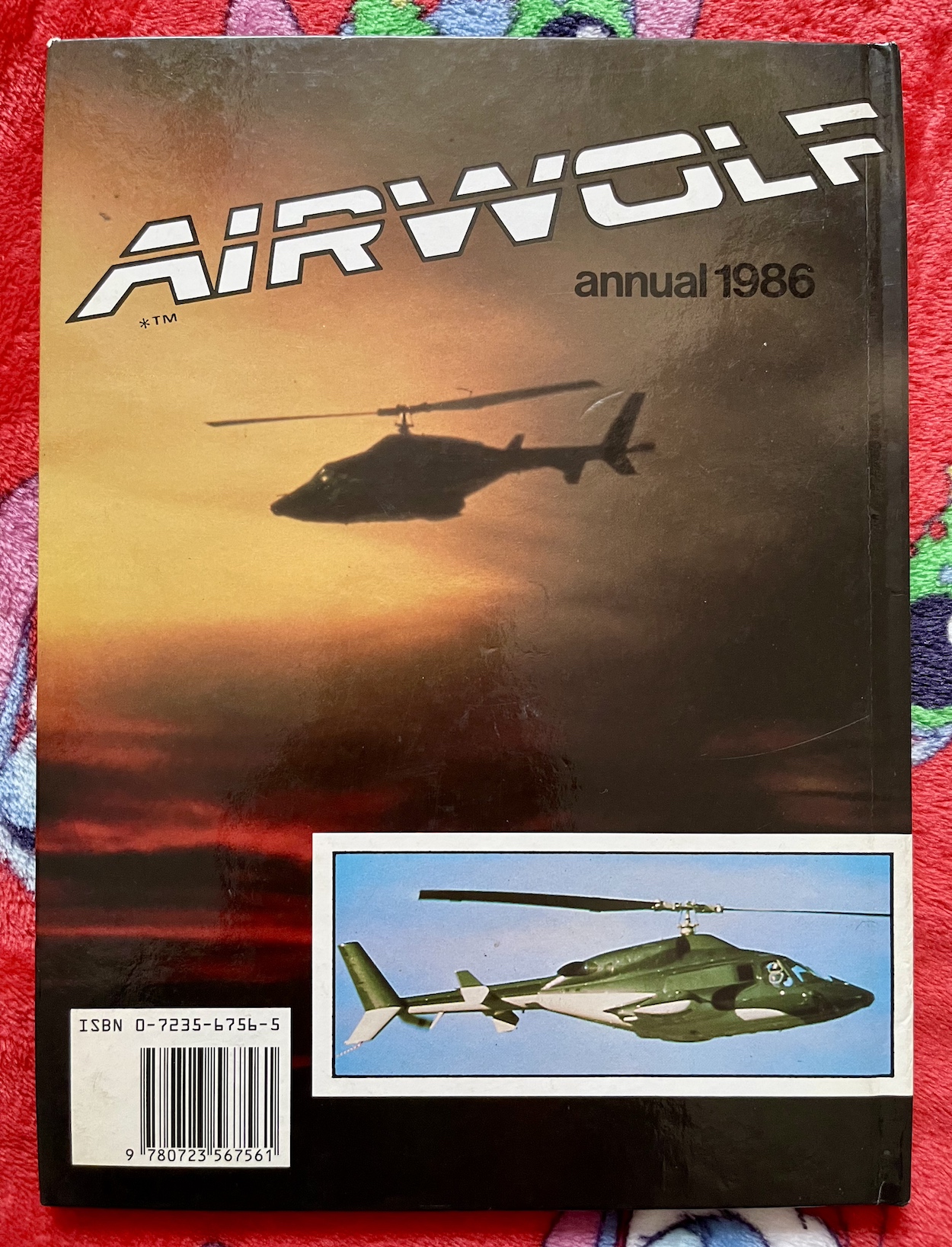
For most fans season one is the best of Airwolf and the closest to creator Donald P. Bellisario’s vision (before the studio started interfering from season two onwards). It keeps to the Cold War theme of that season and the humour of the interactions between the main characters is present, cutting through the drama and intrigue perfectly. On the one hand it’s a shame there isn’t more variety to its contents, but now that I’ve finished it I wouldn’t want to sacrifice any of those six great stories to fit other things in.
The book is easily found on eBay for a few quid, so if you’re an Airwolf nut like me you really shouldn’t miss out on this. Reading it can be bittersweet at times when we remember we’ve lost all three of the main actors in recent years, but the memory of their characters lives on. For me that’s through the BluRay set on my shelf, now proudly accompanied by some superb writing in the Airwolf Annual 1986.






